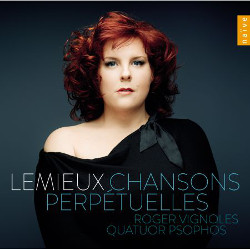March 31, 2015
Fedora in Genoa
If the operas of Giacomo Puccini are the standard bearers for operatic verismo, the stories of Giovanni Verga hold that place in literature. And there was the Casa Sonzogno [an Italian opera publishing house destroyed by a WWII bomb] that sponsored the famous 1888 competition in which Pietro Mascagni’s Cavalleria Rusticana (libretto on a story by Verga) took first place and became the emblematic moment of verismo.
A now forgotten opera by Umberto Giordano, Mala Vita (An Unhappy Life) took sixth place (out of 73 entries) in that competition. Mala Vita is the grizzly tale of a tuberculosis stricken prostitute and was in fact performed in 1890. Note that Puccini’s La boheme premiered in 1896.
Meanwhile in those same years Giordano saw the famed French tragedienne Sarah Bernhardt as Fédora and Puccini saw la Bernhardt as La Tosca, eponymous plays by Victorien Sardou. This facile playwright gave the public what it wanted — intense moments for dramatic outbursts against a colorful historical backdrop, with no demand that the public wade through motivations or contexts.
The operas Fedora (1898) and Tosca (1900) are very similar pieces. Both are three brief acts, both are about a powerful female in a politically volatile climate, both end in suicide. But where Puccini lyrically expands the personalities of his protagonists into rich, post romantic music, Giordano stays very close to the action making his story an intense, fast moving single action. Lyric moments are brief and fiery, generally less than a couple of minutes, the music looking forward to the more direct, minimalist tendencies of twentieth century music drama.
The new production of Fedora in Genoa attempts to bring historical depth to the Sardou play. Stage director Rosetta Cucchi and her set designer Tiziano Santi created a huge, full stage window looking upstage onto an imaginary plain where actions went well beyond the direct, let us say brutal happenings taking place downstage — Fedora’s mortally wounded fiance is brought on stage to die (Act 1), Fedora falls in love with the murderer and betrays him to the police (Act II), Fedora regrets this and kills herself (Act III).
The contexts for these acts played out in this imaginary space were visually splendid if rather confusing. There were battle fields that made us think of the of the 1916 revolution far more than remind us of the the specific context of Sardou’s play — the 1881 assassination of Alexander II. This impression was reinforced by a tableau portrait by costumed supernumeraries of the Czar’s family that made us think of the 1918 murders of the Romanov family. [See lead photo.]
To complicate these contexts the whole opera was played as a flashback — a duplicate Loris (as the by now very aged assassin of Fedora’s fiance) sat on the stage apron for the entire opera (including intermissions) only to walk into the imaginary plain in the final moments of the opera for a brief encounter/recognition of a young goatherd, perhaps the youngest son of the assassinated Ivan the Terrible. Or what?
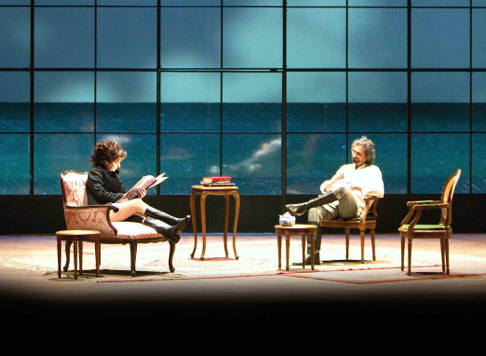 Daniela Dessi as Fedora, Fabio Armiliato as Loris, Act III
Daniela Dessi as Fedora, Fabio Armiliato as Loris, Act III
Of course none of this really mattered because Giordano’s opera is about the immediate passions of a rich Russian aristocrat, the widow Fedora. Fedora was sung by 56 year-old diva Daniela Dessi. Loris, the assassin of her fiancé and a suspected nihilist, was sung by 59 year-old Fabio Armiliato (both ages determined by birth dates found on the internet). These two formidable artists are partners in real life. Both were in good voice, but voices no longer capable of carving Giordano’s unique vocal exclamations in easy tones, relying instead large, uncolored wooden sounds. It was obvious that both artists knew well and once embodied the vocalism and the musicality of the style, and that they were working hard and honestly to achieve it again. The result was compromised.
Fedora’s friend Olga was enacted by Russian soubrette Daria Kovalenko, ably creating the intended overbearing presence of such a Slavic personality. Pianist (in real life) Siriio Restani, the Carlo Felice house pianist, had his moment in the spotlight giving the Act II solo concert against which Fedora and Loris declare their love in a precious scene that would find itself perfectly at home in the shallow sensualism and sensationalsim of Italian decadentismo, a parallel style to gritty verismo.
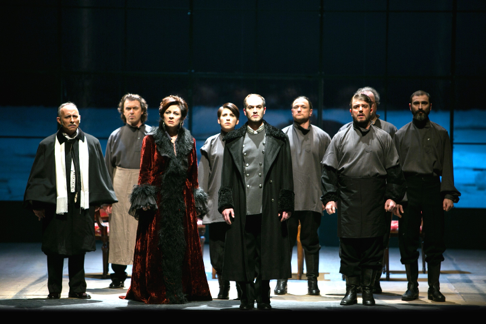 Daniela Dessi as Fedora, male supporting cast
Daniela Dessi as Fedora, male supporting cast
The myriad of smaller roles were executed with typical Italian panache.
The greater impact of the evening was lost by a late start for the brief first act, explained somewhat by an announcement about some casting problem, then there was an overly long first intermission. After the brief second act there was a very extended intermission (one can assume there was some backstage drama, left unexplained). The orchestra players became impatient and began stamping their feet, and finally we were given the brief third act. The far less-than-sold-out house gave la Dessi a huge ovation.
The pit at the Teatro Carlo Felice does not offer a great presence to an orchestra. None the less it was obvious that we were in fine musical hands. Young conductor Valerio Galli, already a verismo specialist, made the most of Giordano’s sophisticated score over this too long evening.
Michael Milenski
Cast and production information:
Fedora: Daniela Dessì; Loris: Fabio Armiliato; De Siriex: Alfonso Antoniozzi; Olga: Daria Kovalenko; Dimitri: Margherita Rotondi; Desiré: Manuel Pierattelli; Il Barone Rouvel: Alessandro Fantoni; Cirillo: Luigi Roni; Boroff: Claudio Ottino; Gretch: Roberto Maietta; Lorek: Davide Mura; Nicola: Matteo Armanino; Sergio: Pasquale Graziano; Michele: Roberto Conti; Boleslao Lazinski: Sirio Restani. Chorus and Orchestra of Teatro Carlo Felice. Conductor: Valerio Galli; Metteur en scène: Rosetta Cucchi; Set Design: Tiziano Santi; Costumes: Claudia Pernigotti; Lighting: Luciano Novelli. Teatro Carlo Felice, Genoa, March 25, 2015.
image=http://www.operatoday.com/Fedora_Genoa1.png
image_description=Daniela Dessi as Fedora, Act II [Photo courtesy of Teatro San Carlo]
product=yes
product_title=Fedora in Genoa
product_by=A review by Michael Milenski
product_id=Above: Daniela Dessi as Fedora, Act II
Photos courtesy of the Teatro San Carlo
March 30, 2015
The Marriage of Figaro, LA Opera
Pierre-Augustin Caron de Beaumarchais wrote Le Mariage de Figaro (The Marriage of Figaro) as a sequel to his Le Barbier de Seville, (The Barber of Seville). In his preface to the play, the author notes that it was the Prince of Conti who requested him to continue the story. Figaro, who actually represents the author, advocates revolution much more avidly in the play than in the opera. The play’s Paris premiere on April 27, 1784 was an enormous success. It ran for sixty-eight consecutive performances, earning higher box-office receipts than any other eighteenth century French play. Sources say that the author donated his profit to charity. The first English production opened late that same year and ran into early 1785.
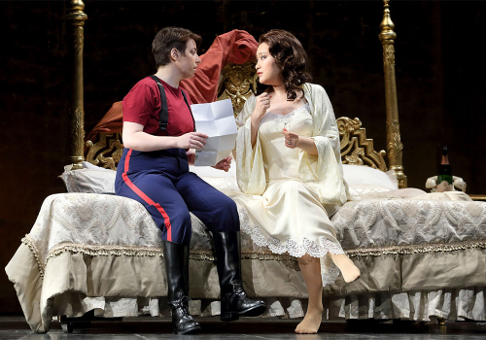 Renee Rapier as Cherubino and Guanqun Yu as the Countess
Renee Rapier as Cherubino and Guanqun Yu as the Countess
Beaumarchais was a great deal more than just a playwright; he was also an arms dealer who was active in both the French and American Revolutions. Before 1778, when France officially entered the American war, the writer saw to the delivery of munitions, money and supplies to the colonists. The Central Intelligence Agency still has a file on him that was not declassified until 1993. It can be seen here.
On March 26, 2015, Los Angeles Opera presented Mozart’s Le nozze di Figaro (The Marriage of Figaro), the libretto of which writer Lorenzo da Ponte based on Beaumarchais’ Le Mariage de Figaro. The Ian Judge production featured jewel-colored box sets by Tim Goodchild that threw the voices out into the hall. Only for the finale did the set open up on to a garden that filled the whole stage and at the very end featured actual fireworks. The eclectic costume designs by Deidre Clancy did not set the action in any particular era.
Roberto Tagliavini was a magnificent Figaro who commanded the stage while out manouvering the Count. Tagliavini has a stentorian bass baritone voice with a robust delivery. He is a valuable asset to the company, as is Operalia winner Guanqun Yu who sang the Countess. She sang with radiant, creamy tones and impressive technical ability including an exquisite trill. As the Count, Ryan McKinny was a strict taskmaster who thought no underling should notice his foibles. He sang with dark, vigorous sounds. Pretty Yende was a piquant Susanna who paced herself well for this long role. She sang her last act aria with floods of lustrous tone. Renée Rapier’s Cherubino was a bubbly teenager who kept the action moving swiftly. His girlfriend, Barbarina, portrayed by So Young Park, sang her aria with radiant silvery tones. I understand she will sing the Queen of the Night next year.
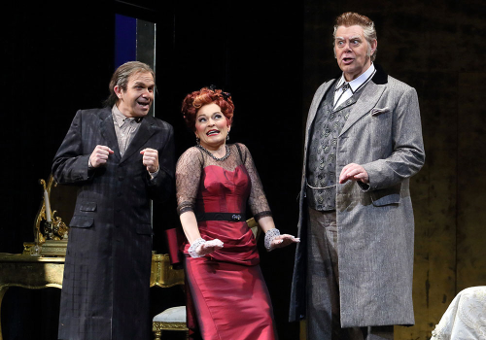 Robert Brubaker as Don Basilio, Lucy Schaufer as Marcellina and Kristinn Sigmundsson as Doctor Bartolo
Robert Brubaker as Don Basilio, Lucy Schaufer as Marcellina and Kristinn Sigmundsson as Doctor Bartolo
Bass Kristinn Sigmundsson was a lawyerly but lovable Dr. Bartolo who sang his patter with speed and accuracy. As Marcellina, who was once his lover, Lucy Schaufer was the embodiment of a difficult 1950s superdiva, and she sang at least as well. Joel Sorensen was a wonderfully amusing notary, Philip Cokorinos a convincing drunk, and Robert Brubaker a malicious Don Basilio. Chorus Director Grant Gershon’s singers sang with clear diction as they communicated Mozart’s subtle nuances.
One of the best reasons for attending opera in Los Angeles is the conducting of James Conlon. His Mozart is always magical and this performance was no exception. His tempi were fresh and his interpretation revealed sonorities that are occasionally missed. Los Angeles Opera brought us a fabulous cast and they sang one of the best renditions of The Marriage of Figaro that I have head in quite a few years.
Maria Nockin
Cast and production information:
Figaro, Roberto Tagliavini; Susanna, Pretty Yende; Count Almaviva, Ryan McKinny; Countess Almaviva, Guanqun Yu; Cherubino, Renée Rapier; Doctor Bartolo, Kristinn Sigmundsson; Marcellina, Lucy Schaufer; Don Basilio, Robert Brubaker; Don Curzio, Joel Sorensen; Barbarina, So Young Park; Antonio, Philip Cokorinos; Conductor, James Conlon; Director, Ian Judge; Scenery Designer, Tim Goodchild; Costume Designer, Deirdre Clancy; Lighting Designer, Mark Doubleday; Chorus Director, Grant Gershon; Original Choreographer, Sergio Trujillo; Choreographer, Chad Everett Allen.
image=http://www.operatoday.com/Figaro_002-Pb.png
image_description=Roberto Tagliavini as Figaro and Pretty Yende as Susanna [Photo: Craig T. Mathew / LA Opera]
product=yes
product_title=The Marriage of Figaro, LA Opera
product_by=A review by Maria Nockin
product_id=Above: Roberto Tagliavini as Figaro and Pretty Yende as Susanna
Photos: Craig T. Mathew / LA Opera
March 29, 2015
Beyond Falstaff in ‘Die lustigen Weiber von Windsor’: Otto Nicolai’s Revolutionary ‘Wives’
By John R Severn [Music & Letters, February 2015]
This article explores how Otto Nicolai and Salomon Hermann von Mosenthal’s Die lustigen Weiber von Windsor (Berlin, 1849) might contribute to an alternative reception history of Shakespeare’s The Merry Wives of Windsor, in which the play’s unusual features—in particular the central role it gives to female agency, family life, and the natural world—are positively valued.
Scheherazade.2: Violin, cimbalom and female empowerment star in John Adams’ new work
By Rebecca Lentjes [Bachtrack, 28 March 2015]
John Adams has been known to draw inspiration from American writers—Walt Whitman, E. Annie Proulx—for his works, but his most recent composition, Scheherazade.2, is presented as a musical sequel of sorts to the sprawling Middle Eastern collection One Thousand and One Nights. Mr Adams explained at the piece’s world première on Thursday…
The Tempest Songbook, Gotham Chamber Opera
A co-production with The Martha Graham Dance Company, the evening’s program was directed and choreographed by Luca Veggetti. The narrative of The Tempest is so deliberately surrealistic that I found the resistance of narrative in the program engaging, rather than the reverse. To this Shakespeare aficionado, the interpolations by Dryden sounded strange, but it was these interpolations that much of the 1712 incidental music, attributed to Henry Purcell, was designed to set. The Purcell and Kaija Saariaho‘s 2004 Tempest Songbook for soprano, baritone and period instrument ensemble intertwined in fascinating ways. In this version, it was receiving its world premiere, and I loved the textures of harpsichord, recorder, and archlute (archlute!) in Saariaho’s unconventional harmonies. It was at Saariaho’s suggestion that the two pieces appeared thus interwoven, and the dialogue between them was musically rich and intellectually stimulating.
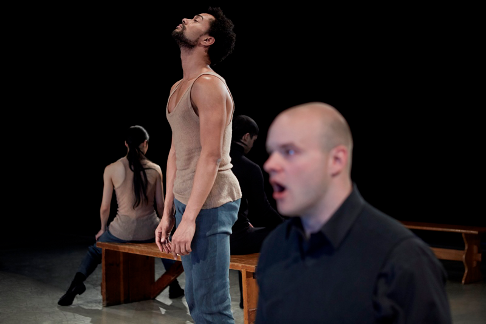
The creative set design was by Jean-Baptiste Barrière. It seems almost a misnomer to call it minimalist, so richly multivalent was the globe that hung elegantly suspended by ropes reminiscent of the fated ship’s rigging. Light projections onto it were skillfully used to evoke globes of the kind so beloved at the courts of early modern Europe, with seas and continents shifting under maps of the zodiac, charts of the stars. Images of the singers and dancers also often appeared there, mirroring and amplifying the action on the stage. The music of Purcell and Saariaho appeared in alternate sections throughout most of the evening, with a suite of Saariaho’s songs in the second half of the hour-long program, which was performed without intermission. From a fairly straightforward presentation of the initial scenes of The Tempest, with the panic and anger of the Bosun, and the terror and sorrow of Miranda, the structure became increasingly impressionistic, with Saariaho’s music allowing Ariel and Caliban (for instance) much more time than the source material gives them.
Eight musicians of the Gotham Chamber Opera orchestra played with admirable verve and versatility under the leadership of Neal Goren. Transitions between the baroque and the contemporary never felt rough or forced. I enjoyed not only the brio with which they handled the moods of the Purcell, from ceremonial to cheerful, but the skill with which they explored the rich and varied textures of the Saariaho. This was especially notable in the Bosun’s Lament, where the orchestra musicians echoed the “Roaring, shrieking, howling” of the spirits described by the increasingly desperate seaman. As we moved to Prospero’s isle, the dancers began to take turns in center stage, sometimes mirroring the movements of the singers, sometimes giving bodily expression (with skill that took my breath away) to the emotions they voiced. In acting for Ariel and Caliban, respectively, Peiju Chien-Pott and Abdiel Jacobsen gave performances of extraordinary intensity.
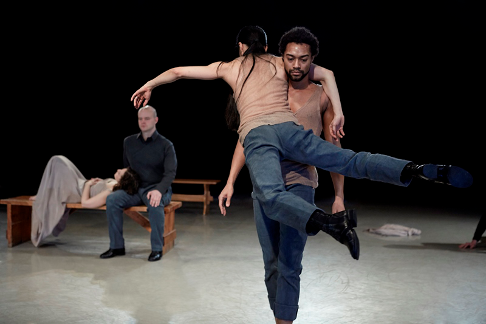
Soprano Jennifer Zetlan and bass-baritone Thomas Richards faced the challenges not only of singing music in two very different styles, but of voicing a diverse array of characters: Prospero and Miranda; Ariel and Caliban; the bosun and the god of the sea. Zetlan handled the vocal lines and the emotional arc of Miranda’s Lament (Saariaho) well, but it was as the sprite Ariel that she really shone, both in the magnificent self-declaration (combining several of the speeches to Prospero) and the exquisite “Full fathom five...”, which was the penultimate section of the program. This was my first time hearing Thomas Richards, and I was very favorably impressed both by his stage presence and by his full-voiced, plangent singing. He sang both the Saariaho and the Purcell with great expressivity. My Musicologist Roommate, who accompanied me, wanted more ornamentation, but Richards made very fine use of vocal coloring. Saariaho’s setting of Caliban’s Dream I thought especially lovely. In a traditional production of Shakespeare’s play, the optimistic concluding ensemble (recording here) would seem strangely inopportune, but here, it seemed only fitting. The program will be given two more performances in this run, and could provide an interesting addition to the repertoire of small companies.
This review first appeared at Opera Obsession. It is reprinted with permission of the author.
image=http://www.operatoday.com/2015-2728_0289.png image_description=Scene from The Tempest Songbook [Photo by Julieta Cervantes] product=yes product_title=Henry Purcell/Kaija Saariaho: The Tempest Songbook product_by= product_id=Above: Scene from The Tempest SongbookPhotos by Julieta Cervantes
March 26, 2015
San Diego Opera presents Adams’ Riveting Nixon in China
Director Peter Sellars first suggested the idea for the opera to Adams and eventually convinced him that the piece would be viable despite a lack of action. Alice Goodman then did considerable research into United States President Richard Nixon’s 1972 visit to China. Adams, interested in myths and their origins, thought that the opera could show the original history behind Nixon’s mythic visit. He and Sellars wanted a heroic baritone to play the role of Nixon. For this, his first opera, Adams’ usual minimalist music also shows the influence of Wagner and Stravinsky along with jazz and big band sounds. It’s a fascinating mix that we don’t always hear in his later works.
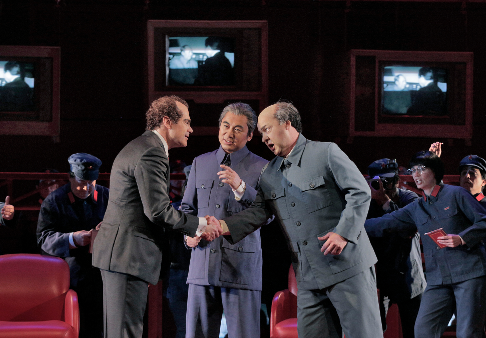 Franco Pomponi as Richard Nixon, Chen-ye Yuan as Chou En-Lai, and Chad Shelton as Mao Tse-Tung
Franco Pomponi as Richard Nixon, Chen-ye Yuan as Chou En-Lai, and Chad Shelton as Mao Tse-Tung
San Diego Opera staged Nixon in China on March 17, 2015, in a production by James Robinson with interesting sets by Allen Moyer suggesting 1970s television. James Schuette added authentic costuming from the era. Adams has chosen to have the singing amplified in his operas so there was a sound designer, Brian Mohr. There was considerable ballet in this opera and choreographer Seán Curran, along with principal dancers Julio Cantano-Yee and Khamla Somphanh, made it a most welcome and integral part of the show. Loved the dancers as whirling waiters at the banquet.
Franco Pomponi was a more than life sized Richard Nixon who sang his lines with the robust heroic sound Adams originally envisioned. Chen-ye Yuan was an officious Chou En-Lai and Chad Shelton was an elderly but still mentally capable Mao Tse-Tung. Sarah Castle, Buffy Baggott and Jennifer DeDominici comprised the trio of dissonant secretaries who always surrounded Mao. Although women had lesser roles in the actual visit, they had major parts in the opera. Kathleen Kim was a fabulous Madame Mao who sang one of the most difficult coloratura arias ever written as though it was an easy tune. With the simple costume of a Chinese working woman, she showed her artistry with filigrees of sound. As Pat Nixon, lustrous voiced Maria Kanyova was the girl next door who dearly loved the husband with whom she was swept up into history. Always a wonderful character actor, Patrick Carfizzi made Henry Kissinger as interesting and cantankerous as he was during the seventies.
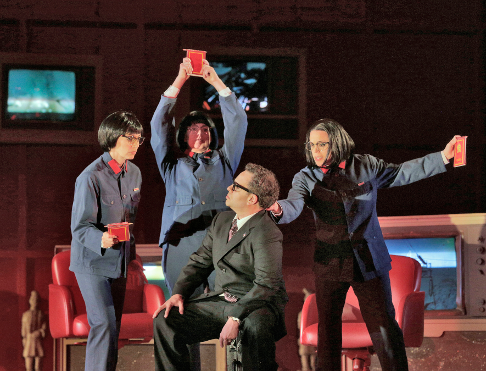 (L-R) Sarah Castle as the 1st Secretary to Mao, Buffy Baggott as the 2nd Secretary to Mao, Jennifer DeDominici as the 3rd Secretary to Mao, and Patrick Carfizzi as Henry Kissinger
(L-R) Sarah Castle as the 1st Secretary to Mao, Buffy Baggott as the 2nd Secretary to Mao, Jennifer DeDominici as the 3rd Secretary to Mao, and Patrick Carfizzi as Henry Kissinger
Charles Prestinari’s San Diego Opera Chorus provided an excellent rhythmic and harmonic background for the historic scenes found in Adams’ mythic piece. It was the excellent work of conductor Joseph Mechavich that held stage and pit together and made this piece come alive for the San Diego audience. I hope the new San Diego Opera will give us more contemporary opera and allow us to see new pieces as they begin to enter the repertoire.
Maria Nockin
Cast and production information:
Chou En-Lai, Chen-Ye Yuan; Richard Nixon, Franco Pomponi; Henry Kissinger, Patrick Carfizzi; Mao Tse-Tung, Chad Shelton; Secretaries to Mao: Sarah Castle, Buffy Baggott, Jennifer DeDominici; Pat Nixon, Maria Kanyova; Madame Mao, Kathleen Kim; Conductor, Joseph Mechavich; Production, Houston Grand Opera; Director, James Robinson; Set Designer, Allen Moyer; Costume Designer, James Schuette; Lighting Designer, Paul Palazzo; Sound Designer, Brian Mohr; Choreographer, Seán Curran; Chorus Master, Charles Prestinari.
image=http://www.operatoday.com/NIX_0296a.png
image_description=Franco Pomponi as Richard Nixon and soprano Maria Kanyova as Pat Nixon [Photo by Ken Howard]
product=yes
product_title=San Diego Opera presents Adams’ Riveting Nixon in China
product_by=A review by Maria Nockin
product_id=Above: Franco Pomponi as Richard Nixon and soprano Maria Kanyova as Pat Nixon
Photos by Ken Howard
Ars Minerva presents Castrovillari’s La Cleopatra in San Francisco
Ars Minerva is a new San Francisco based company that is presenting the Carnival Series Project: music that was played during the seventeenth century Venetian season of Carnevale, the name of which means goodbye to meat. This time of year culminated in Martedi Grasso (Mardi Gras/Fat Tuesday) the day before Ash Wednesday, which begins the penitential season of Lent. Carnevale di Venezia was famous not only for its music but also for its elaborate masks, facsimiles of which were on view in the lobby of the Marines Memorial Theater at La Cleopatra.
On March 14 and 15, 2015, Céline Ricci directed the up-to-date, realistic action of Castrovillari’s timeless opera. I saw the matinee performance on the fifteenth. The stage design by Matthew Holmes consisted of necessary pieces of furniture and a screen on which scenic elements were projected as though reflected in an imaginary pool. Together with Brian Poedy’s lighting, each scene was effectively put in its correct setting. Ricci was a glorious Queen Cleopatra whose regal persona turned romantic when she was with Marc Antonio. Vocally, she endowed her music with a wide variety of colors while conveying every emotional expression from protestations of love to death threats.
In this piece, Marc Antonio, sung with a secure line by countertenor Randall Scotting, was a straying husband whose wife, Ottavia, was anything but a wilting flower. Nell Snaidas sang Ottavia with power and passion as she tried to persuade a servant to kill the queen. Igor Viera, dressed in rough clothing and a grass hat, sang Clisterno with a robust sound. Together with Michael Desnoyers as the smart-mouthed, cross dressing elderly servant, Filenia, he brought moments of comic relief to this otherwise dramatic story.
Jennifer Ellis Kampani sang Coriaspe with sumptuous tones and iridescent waves of musical color. Hers is a voice from which I hope to hear a great deal more. Molly Mahoney was a mellifluous Arsinoe and Spencer Dodd sang with burnished tones in the dual roles of Dolabella and Arante.
The Marines Memorial Theater is not overly big and Derek Tam’s Baroque players filled the space with gorgeous sound. Tam played the harpsichord and conducted. Adam Cockerham played theorbo and guitar. Gretchen Claassen played cello, while Natalie Carducci and Laura Rubinstein-Salzedo played first and second violins. It was a great treat to hear this beautiful, well-composed opera that has been unjustly forgotten for so long. Thank you, Céline Ricci, for bringing it to us.
Maria Nockin
Cast and production information:
Cleopatra, Céline Ricci; Marc Antonio, Randall Scotting; Ottavia, Nell Snaidas; Coriaspe, Jennifer Ellis Kampani; Arsinoe, Molly Mahoney; Filenia, Michael Desnoyers; Clisterno, Igor Viera; Dolabella/Ariante, Spencer Dodd; Augusto, Anders Froelich; Domitio, James Hogan; Director, Céline Ricci; Video Stage Design, Matthew Holmes, Lighting Design, Brian Poedy; Conductor, Derek Tam; Theorbo and Guitar, Adam Cockerham; Cello, Gretchen Claassen; Violin I, Natalie Carducci; Violin II, Laura Rubinstein-Salzedo.
image=http://www.operatoday.com/La_Cleopatra.jpg
image_description=
product=yes
product_title=Ars Minerva presents Castrovillari’s La Cleopatra in San Francisco
product_by=A review by Maria Nockin
product_id=
World Premiere of Jennifer Higdon’s opera Cold Mountain at Santa Fe Opera this August
Jennifer Higdon’s first opera, Cold Mountain, premieres at The Santa Fe Opera on August 1, 2015 and runs until August 22. In addition, Opera Philadelphia recently announced that they will give the East Coast premiere of Cold Mountain during their 2015-16 season. This Monday at 7:30 p.m., the Guggenheim Museum in New York will host a special event: Higdon, author Charles Frazier, stage director Leonard Foglia and librettist Gene Scheer will discuss the new opera, and Cold Mountain cast members Isabel Leonard, Emily Fons, Jay Hunter Morris, Kevin Burdette, and Roger Honeywell will perform musical selections. For more information, click here .
Cold Mountain takes an American story as its subject—the desertion of Confederate soldier W.P. Inman to return to his love in the mountains of North Carolina during the Civil War. Based on Charles Frazier's best-selling novel, which was turned into an award-winning movie, it features a libretto by Gene Scheer ( Moby-Dick; An American Tragedy), recounting Inman's dangerous odyssey, trekking across North Carolina back to Cold Mountain. This Santa Fe Opera, Opera Philadelphia, and Minnesota Opera co-commission stars Nathan Gunn as the soldier Inman, Isabel Leonard as his lover, Ada, and Jay Hunter Morris as the villainous Teague in both Santa Fe and Philadelphia.
Winner of the Pulitzer Prize in Music for her Violin Concerto and one of America’s most-performed composers, Jennifer Higdon taught herself the flute at the age of 15 and began to compose at 21. Of the 50 recordings of her work, Percussion Concerto, Higdon: Concerto for Orchestra/City Scape, Strange Imaginary Animals, and Transmigration have all won Grammy Awards. Her work blue cathedral has been performed more than 500 times since its premiere in 2000. Higdon also teaches composition at the Curtis Institute of Music in Philadelphia.
"I didn't realize that I would be carrying these characters in my head and heart for about two and a half years,” Higdon told NPR Music . “But in many ways, living inside the opera, which it felt like I did, was not like anything I've ever experienced before. The entire group stayed with me day and night. I've been pretty absent from the present-day world for quite some time. That type of concentrated creativity has been amazing to experience.”
“I think Cold Mountain is going to be the great American operatic work,” said Gunn. “The music is beautiful and amazingly dramatic in scope.”
“Charles Frazier’s Cold Mountain is a beautiful story filled with history, love, fear, and courage,” said Leonard. “Jennifer Higdon and Gene Scheer have now turned that story into an incredible musical journey and I cannot wait to share it with the people of Santa Fe and Philadelphia.”
“The greatest moments, for me, are when I get to sing new music,” said Hunter Morris. “I love stepping into the character and stepping into the voice for the first time.”
The
Guggenheim
March 30, 2015
Santa
Fe Opera
August 1, 5, 14, 17, 22, 2015
Opera
Philadelphia
February 5, 7, 10, 12, 14, 2016
Copyright © 2015 First Chair Promotion, All rights reserved.
image=http://www.operatoday.com/Higdon-Slight-Smile.png image_description=Jennifer Higdon [Photo by J. Henry Fair] product=yes product_title=World Premiere of Jennifer Higdon’s opera Cold Mountain at Santa Fe Opera this August product_by=First Chair Promotion Press Release product_id=Above: Jennifer Higdon [Photo by J. Henry Fair]An Ideal Cast in Chicago’s Tannhäuser
The Chicago performances include Johan Botha as Tannhäuser, Amber Wagner in the role of Elisabeth, Gerald Finley as Wolfram von Eschenbach, Michaela Schuster as Venus, and John Relyea as Landgraf Hermann. Also participating in these performances are Jesse Donner as Walter, Daniel Sutin as Biterolf, Angela Mannino as the Shepherd, Corey Bix as Heinrich, and Richard Wiegold as Reinmar. Sir Andrew Davis conducts the Lyric Opera Orchestra and Michael Black has prepared the chorus, both groups here performing at the level of a festival. The production is directed by Tim Albery. Messrs. Bix, Wiegold, and Albery are in their debut season at Lyric Opera.
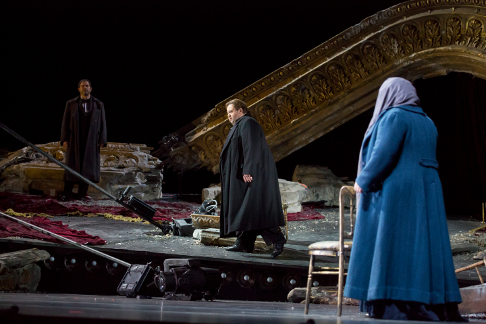 Gerald Finley as Wolfram, Johan Botha as Tannhäuser, and Amber Wagner as Elisabeth
Gerald Finley as Wolfram, Johan Botha as Tannhäuser, and Amber Wagner as Elisabeth
Staging the Venusberg scene is a perennial challenge to dramatic credibility. The current production makes a valiant effort to capture the spirit of music and drama, while matching a modernist updating in dress and stage props. After an impressive performance of the overture’s opening with the horns squarely on pitch and sensitive playing by the violas, the viewer notes a straight-back chair positioned at stage front on the right-hand side. Seated in the chair, dressed in a contemporary suit, is Tannhäuser. From the darkened stage recesses a figure emerges, and a miniature theater-frame with curtain descends onto the main stage, just as the Venusberg music intensifies. As the curtain in this stage-upon-a-stage opens, Venus - draped in a black evening dress - appears at its center. Dressed likewise as a match to the principals in style and formality, the male and female dancers participating in the bacchanal populate the center stage around a longish table. The choreographed motions suggest the physical pleasure to which Tannhäuser has committed himself after his departure from the society of the court. The dancers fulfill here Wagner’s textual summary of undulating movement interspersed with the sirens’ chorus of “Naht euch dem Strande” [“Draw near to the shore”]. Once the pair is alone, Venus questions the grounds for Tannhäuser’s distraction; his reveries simply recall images of nature which are now banned from his experience. In this response Mr. Botha’s recitation signals the tedium of his present, timeless state with drawn-out emphasis on “Tage, Monde …” [“Days, months …”]. In reaction to Ms. Schuster’s expressive “Ergreife Deine Harfe” [“Seize your harp”], Botha begins his praise of Venus [“Dir töne Lob” (“Praise be to you”)] with a lilting and embellished line. Yet in the midst of his love-song Botha’s tone changes effectively with the realization that he is a “Sterblicher” [“mortal”]. After Venus’s offended reaction Tannhäuser repeats both his praise and his appeal to leave her realm. Botha’s lyrical decorations on the line “nach unsrer Vöglein liebem Sange” [“for the sweet song of our beloved birds”] in describing the homeland build the grounds for his repeated declarations on “Freiheit” and “Laß mich ziehn!” [“Freedom” “Let me depart!”]. Resulting from his final dramatic statement, “Mein Heil liegt in Maria” [“My salvation remains with Mary”], delivered by Botha with exciting forte pitches, Tannhäuser is released from the control of Venus and returns to his origins.
Once Tannhäuser is anchored in a familiar landscape, his sense of sinfulness is enhanced. He sees a shepherd beneath a tree, located here toward the rear of the stage, and soon the latter’s song, “Frau Holda,” celebrates the return of pleasant weather. As the shepherd Angela Mannino sings with bright, unforced line, executing lovely decoration on “strahlte” to emphasize the play of the sun’s rays in “da strahlte warm die Sonne” [“and the sun began to shine warmly”]. A troop of pilgrims sings of its devotional passage just as the shepherd wishes them Godspeed to Rome. As an observer Tannhäuser is struck by their piety and laments his guilt even more intensely. In the balance of Act I the remaining male characters of the opera are introduced. The identity of the isolated penitent is first questioned by Landgraf Hermann, then immediately recognized by Wolfram. Messrs. Relyea and Finley inhabit these roles seamlessly. After individual welcoming words the knights and singers encourage Tannhäuser collectively to remain in their midst. Wolfram’s appeal, “Bleib bei Elisabeth!” [“Stay for the sake of Elisabeth!”] turns the tide in the returning knight’s resolve. While elaborating on this statement, Finley’s Wolfram sings a lush melodic passage recalling the effect of Tannhäuser’s departure on Elisabeth. Beginning with thoughts confined to individual verses [“Als du in kühnem Sange uns besrittest” (“When you in daring song did strive with us”)], Finley’s application of legato and transition builds as he proclaims, “O kehr zurück, du kühner Sänger” [“O return to us, you bold singer”]. The palpable effect of these lines, echoed by Relyea’s Landgraf, show Tannhäuser proclaiming his determination to remain in this company at the close of the act.
Act II introduces from its start the heroine Elisabeth. The interior of the palace whose hall she addresses in “Dich teure Halle” [“You, beloved hall”] suffers from neglect. By showing a state of decay, the set seems to externalize the inner ruin of Elisabeth’s and the court’s temperament. Ms. Wagner sings her opening aria with a commitment and power that bodes well for her assumption of yet additional roles in the dramatic-lyric repertoire. Wagner’s believable emphasis in her middle and lower registers to describe the effects of Tannhäuser’s earlier departure [“aus düstrem Traum” (“from gloomy dreams”)] transformed into a joyful declaration of welcome, squarely on pitch, in the repeat of “Sei mir gegrüßt!” [“Be greeted by me!”]. The subsequent duet with Tannhäuser, as they celebrate their reunion in the hall, shows both voices in elevated, forte excitement [“Gepriesen sei die Stunde!” (“Praised be the hour!”)], yet also woven together in emotional harmony.
An orchestral interlude heralds the arrival of guests who will observe the singers perform at the festivity. The latter are addressed directly by the Landgraf [“Ihr lieben Sänger” (“You dear singers”)] when he encourages each to describe while singing “der Liebe Wesen” [“the nature of love”]. Relyea’s diction and sense of communicating the text are exemplary in this extended depiction of the singers’ task. The first to sing is Wolfram in an address which shows Finley lingering convincingly on “die Seele” [“the soul”] and “der Liebe reinstes Wesen” [“love’s purest essence”], as he emphasizes the spirituality of love. Tannhäuser’s demur at this characterization of love is contradicted roundly by Walter von der Vogelweide. Mr. Donner’s Walter is sung with full, nicely rounded voice, laying emphasis on “die Tugend wahr” [“true virtue”] and decorating skillfully the “Inbrunst” [“fervor”] which he derides Tannhäuser for lacking. That very spirituality is flaunted in Botha’s resounding subsequent paean to sensual love. The court’s shocked denunciation of Tannhäuser is interrupted passionately by Elisabeth. Ms. Wagner’s recitation of this monologue contains striking shifts between describing Tannhäuser’s fall and her own sense of inner piety. As she reminds the others that “auch für ihn einst der Erlöser litt” [“the Redeemer suffered once for him as well”], Ms. Wagner leads the assembled members of the court to encourage forgiveness and repentance. In the final ensemble before Tannhäuser leaves on a pilgrimage - tellingly to Rome, as an echo of Act I - individual voices blend here yet are also perceived distinctly in a plea for a potential miracle.
The final act of Tannhäuser continues the passage to that very miracle, yet only after the demonstration of true sacrifice. Elisabeth’s prayer near the start of the act is achingly delivered by Ms. Wagner, as she begs the Virgin Mary to be taken from this earth as a means to atone “für seine Schuld” [“for his transgression”]. Wolfram’s response, when his attempts to follow her to the palace are gently rebuffed, is the prayer to the evening star to accompany Elisabeth in her journey heavenward. Finley’s performance of this piece, “O du, mein holder Abendstern,” is justly lauded, and here his singing matches the wistful yearning of the production’s movements. His voice quivers with devotion, as he graces the words “ein sel’ger Engel dort zu werden” [“to become a blessed angel there”] with fervent embellishment. Tannhäuser’s return signals his final confrontation with the character Wolfram. Botha details with dramatic gesture the rejection of his entreaties at Rome and his determination to return to Venus. In the struggle over the fate of Tannhäuser’s soul, Finley and Botha act with urgency to the point of the chorus announcing Elisabeth’s sacrifice. As the penitent now begs a departed Elisabeth to pray for him, the miracle of the pope’s staff is revealed. The final scenes in these performances are not simply a denouement but rather a convincing resolution of love’s dilemma.
Salvatore Calomino
image=http://www.operatoday.com/17_Corey_Bix_Johan_Botha_Richard_Wiegold_Jesse_Donner_TANNHAUSER_LYR150204_611_cTodd_Rosenberg.png
image_description=Johan Botha as Tannhäuser [Photo © Todd Rosenberg]
product=yes
product_title=An Ideal Cast in Chicago’s Tannhäuser
product_by=A review by Salvatore Calomino
product_id=Above: Johan Botha as Tannhäuser
Photos © Todd Rosenberg
March 22, 2015
Winners of the Metropolitan Opera National Council Auditions Announced
New York, NY (March 22, 2015) — After a months-long series of competitions at the district, regional, and national levels, five young singers have been named the winners of the nation’s most prestigious vocal competition, the Metropolitan Opera National Council Auditions. Each winner receives a $15,000 cash prize and the prestige and exposure that come with winning the competition that launched the careers of many of opera’s biggest stars.
This year’s winners are Nicholas Brownlee, bass-baritone (Western Region: Mobile, Alabama); Marina Costa-Jackson, soprano (Middle Atlantic Region: Salt Lake City, Utah); Joseph Dennis, tenor (Eastern Region: McKinney, Texas); Reginald Smith, Jr., baritone (Southeast Region: Atlanta, Georgia); and Virginie Verrez, mezzo-soprano (Eastern Region: Brive La Gaillarde, France, currently living in New York, New York).
Earlier this afternoon, nine finalists performed on the Met stage in the final phase of the competition. Each sang two arias with the Met orchestra, led by the company’s Principal Conductor, Fabio Luisi. The audience for the Grand Finals Concert included artistic directors of leading opera companies, artist managers, important teachers and coaches, music critics, and many other industry professionals with the potential to play an influential role in the career of a young singer.
The Met Auditions, currently in their 62nd year, were the public’s first introduction to many of today’s best-known stars, including Renée Fleming, Susan Graham, Thomas Hampson, Eric Owens, Sondra Radvanovsky, Frederica von Stade, and Deborah Voigt. Recent winners who have gone on to embark on major operatic careers include Paul Appleby, Jamie Barton, Anthony Roth Costanzo, Michael Fabiano, Lisette Oropesa, Susanna Phillips, Alek Shrader, and Amber Wagner. 126 singers who participated in the National Council process early in their careers are on the Met’s roster in the current season.
The Grand Finals Concert was hosted by current Met star Angela Meade, who first came to prominence in 2007 as a winner of the National Council Auditions. Meade sang “Ebben?…Ne andrò lontana” from Catalani’s La Wally and “Casta Diva” from Bellini’s Norma while the judges deliberated. The concert was recorded for broadcast at a later date on public radio stations across the United States.
The remaining four finalistsJared Bybee, baritone (Middle Atlantic Region: Modesto, California); Allegra De Vita, mezzo-soprano (New England Region: Trumbull, Connecticut); Kathryn Henry, soprano (Upper Midwest Region: Sheboygan, Wisconsin); and Deniz Uzun, mezzo-soprano (Central Region: Mannheim, Germany, currently living in Bloomington, Indiana)—each received a cash prize of $5,000.
The regional and district-level auditions, held across the U.S. and Canada, are sponsored by the Metropolitan Opera National Council and administered by National Council members and hundreds of volunteers from across the country. Given the reach of the auditions, the number of applicants, and the program’s long tradition, the Metropolitan Opera National Council Auditions are considered the most prestigious competition for singers seeking to launch an operatic career.
Nicholas Brownlee
Bass-Baritone (Mobile, Alabama)
Age 25
In the 2015-16 season, Nicholas Brownlee will be returning for his second year as a Domingo Colburn Stein Young Artist at Los Angeles Opera, where he will be heard as Colline in La Bohème, the Speaker in Die Zauberflöte, the Bonze in Madama Butterfly, and the Gardener in Jake Heggie’s Moby-Dick. Next season also includes his Atlanta Opera debut as Colline. He will also be returning for his second season at Santa Fe Opera this summer as the First Soldier in Salome. This season he made debuts with the Los Angeles Philharmonic as the bass soloist in the Beethoven Choral Fantasy, as well as London’s Barbican Centre in performances of Unsuk Chin’s Alice in Wonderland, co-produced with the Los Angeles Philharmonic. He is a First Place winner of the Palm Springs Opera Guild Competition as well as a national semi-finalist in the 2011 Metropolitan Opera National Council Auditions. Western Region.
Marina Costa-Jackson
Soprano (Salt Lake City, Utah)
Age 27
Marina Costa-Jackson is a third-year resident artist at the Academy of Vocal Arts in Philadelphia, where she is heard this season as Mimì inLa Bohème and as Marguerite in Faust. In Philadelphia, she has also sung Lisa in The Queen of Spades and Amelia in Un Ballo in Maschera. She appeared at Madison Square Garden last year with Andrea Bocelli and has recently returned from a concert tour in Russia with Dmitri Hvorostovsky’s “Dmitri and Friends”. She received first prize in the Giulio Gari Foundation, was a second place winner with the Marcello Giordani Foundation, a finalist in the International Hans Gabor Belvedere Competition, and an award winner with the Opera Index, Licia Albanese-Puccini Foundation, Mario Lanza Institute, Sergio Franchi Music Foundation, and George London Foundation. She will make her professional debut next season with Michigan Opera Theater as Musetta in La Bohème. Middle Atlantic Region.
Joseph Dennis
Tenor (McKinney, Texas)
Age 30
In 2013 Joseph Dennis appeared with the Santa Fe Opera as Giuseppe in La Traviata and last summer returned to that company for the title role in the American premiere of Huang Ruo’s Dr. Sun Yat-Sen. This season he sings Števa in Jen˚ufa with Des Moines Metro Opera. He has also appeared with the Palm Beach Opera as Malcolm in Macbeth and in productions of Il Barbiere di Siviglia and Les Contes d’Hoffmann. He pursued theater studies at Collin College and vocal performance at Stephen F. Austin State University, where his roles include Elder Gleaton in Carlisle Floyd’s Susannah, Kaspar in Menotti’s Amahl and the Night Visitors, Alfred inDie Fledermaus, and Gastone in La Traviata. At the University of Oklahoma he sang Pylades in Gluck’s Iphigénie en Tauride and Fenton in Falstaff. This fall he joins the ensemble of the Vienna State Opera. Eastern Region.
Reginald Smith, Jr.
Baritone (Atlanta, Georgia)
Age 26
Reginald Smith, Jr. is a studio artist with the Houston Grand Opera and his operatic repertoire includes the title role of Falstaff, Germont inLa Traviata, Marullo in Rigoletto, the Speaker in Die Zauberflöte, Dr. Falke in Die Fledermaus, and Figaro in Le Nozze di Figaro. On the concert stage he has appeared with the Houston Symphony Orchestra, Atlanta Symphony Orchestra, Lexington Philharmonic, Kentucky Symphony Orchestra, Owensboro Symphony Orchestra, Johnson City Symphony, the Evansville Symphony Orchestra, and the Cincinnati Pops. He has been a reward recipient in the George London Foundation Competition, Dallas Opera Guild Vocal Competition, and received first place in the Orpheus Vocal Competition and National Opera Society Competition. This summer he joins the Wolf Trap Opera as a Filene Young Artist where he will sing Count Almaviva in Le Nozze di Figaro. Southeast Region.
Virginie Verrez
Mezzo-soprano (Brive La Gallarde, France)
Age 26
Virginie Verrez received her bachelor of music degree from the Juilliard School where she is continuing her music studies on a Kovner Fellowship. Last month at Juilliard she sang Clytemnestre in Gluck’s Iphigenie en Aulide as part of the Met+Juilliard program. She has previously sung Beatrice in Wolf-Ferrari’s Donne Curiose, Zenobia in Handel’s Radamisto, and Junon in Charpentier’s Acteon at Juilliard, and additional performances include Lola in Cavalleria Rusticana with Avignon Opera and Mercédès in Carmen with Wolf Trap Opera. In 2014 she was a soloist in Beethoven’s Symphony No. 9 with the Philadelphia Orchestra and made her Carnegie Hall debut in Bruckner’s Te Deum. She is a prize winner of the Opera Index Competition, McCammon Competition, Licia Albanese-Puccini Foundation, and Gerda Lissner Foundation. This fall she will become a member of the Metropolitan Opera’s Lindemann Young Artist Development Program. Eastern Region.
image=http://www.operatoday.com/Met_audition_winners.png image_description=2015 National Council Winners: (from l to r) Reginald Smith, Jr., Virginie Verrez, Joseph Dennis, Marina Costa-Jackson, Nicholas Brownlee [Photo courtesy of The Metropolitan Opera] product=yes product_title=Winners of the Metropolitan Opera National Council Auditions Announced product_by= product_id=Above: 2015 National Council Winners: (from l to r) Reginald Smith, Jr., Virginie Verrez, Joseph Dennis, Marina Costa-Jackson, Nicholas BrownleePhoto courtesy of The Metropolitan Opera
A Chat with Julia Noulin-Mérat
She is the Associate Producer for Boston Lyric Opera and the Director of Design and Production for Boston’s Guerilla Opera. She is also the resident set designer for the New York’s Attic Theatre Company. Some of her designs include: Bluebeard’s Castle for Opera Omaha, Xerxes for the Connecticut Early Music Festival, and Madama Butterfly for El Paso Opera. Her engagements for the 2015-2016 season are with Nationale Reisopera, Gotham Chamber Opera, Boston Lyric Opera, and Castleton Festival.
Today she drops by for an interview with our Maria Nockin.
MN: Julia, how do you come to have three citizenships?
JNM: My dad is Canadian and my mom is French. Thus, I was born with both of those. Since I went to graduate school in the United States, I became an American citizen. Some things have changed since Nine-Eleven. You used to have to relinquish your Canadian citizenship before becoming an American. Now you don’t have to do that anymore.
MN: Where did you grow up?
JNM: I grew up a little bit everywhere! First, I lived in Montreal, then in Paris. I’ve also lived in Belgium. My dad worked in research for a pharmaceutical company, so we traveled a great deal, but I went back to Montreal to do my undergraduate work at Concordia University. Originally, I wanted to be a physician and I began to study for it, but I got the design bug. I don’t regret it. I’m lucky to have discovered what I like to do at such a young age. A friend of mine who lived in my dorm said: “Julia, you are always at the theater or at the museum. You have art hanging in your room. Don’t you think you should do something that pertains to the theater? “ When I said I’m not a performer, he replied that there are other aspects of theater. Eventually, I did an internship in set design and I fell in love with the work.
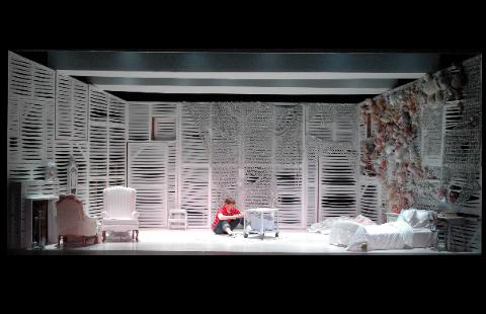 A scene from L’Enfant et les Sortileges – Boston Conservatory [Photo by Julia Noulin-Mérat]
A scene from L’Enfant et les Sortileges – Boston Conservatory [Photo by Julia Noulin-Mérat]
MN: What is your mission as a designer?
JNM: I want to make sure that the entire evening’s presentation is an event for the audience from when the doors open until they close. I want every performance to be as engaging and as exciting as possible. Opera in particular requires all the art forms to come together. In it there is not only singing and orchestral music, but also dancing and visual art. Although I am in the performing arts world, I feel like a visual artist. Many times people forget that.
When I was an undergraduate, I took a fabulous class called Performance for Designers. In it, they made us wear tight corsets and the highest possible heels. We had to perform on a raked stage on which normal chairs would topple over. That definitely made us think about whether or not performers could work comfortably within our designs. Some years later, one of my own students wanted his audience to sit on Astroturf. The next week that class sat on it. After twenty minutes some of them asked to return to the chairs. I told them that if they want the audience to sit on it for three hours, they could do it for the length of the class. Three years after that, I met a carpenter on a show who told me that her boyfriend still spoke of my “Astroturf class”.
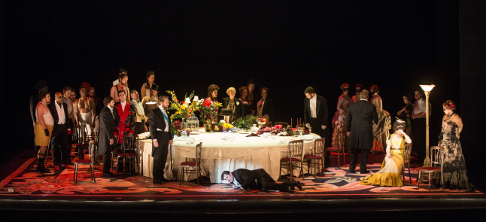 A scene from La traviata – Boston Lyric Opera [Photo by Aram Boghosian]
A scene from La traviata – Boston Lyric Opera [Photo by Aram Boghosian]
MN: Did you get any significant insight from a teacher or mentor?
JNM: John Conklin is a colleague and a mentor that I met through Boston Lyric Opera. I have worked with him for almost four years. He is an incredibly talented artist and I get a thrill out of everything we work on together. He always approaches an opera with totally fresh eyes. I find it inspiring to see this man who has been in the business for many years rediscover each work that he approaches. If I can do a mere half of what he does, I will be immensely happy.
MN: What productions have you done with him?
JNM: With Boston Lyric Opera, he’s designed Rigoletto that also went to Opera Omaha and Atlanta Opera. Right now we are gearing up for next season, which includes La Bohème, Werther and The Merry Widow. I designed a set for La Traviata alone, too, but it is amazing to have John to bounce ideas off of.
One of the reasons I chose Boston University for graduate school was its Opera Institute. It was very important for me to attend a design school that had a close relationship with an opera department. A program with no opera would have been a waste of time for me. My relationships with singers would not be the same if I had gone to a school where students only designed for the theater. In Boston, I worked with the amazing Sharon Daniels who taught me what to worry about and how to deal with singers. The Institute had guest directors, as well. That helped me learn to deal with different working styles and enabled me to form important relationships. One of the directors I met in grad school was Nathan Troup who staged Francesco Cavalli’s La Calisto for Simpson College in January 2015. We’ve been working together for nine years now and have done over fifteen new productions.
Since I was in Boston, which is a composer’s town, I became connected with Guerilla Opera. I have been working with that company since its second year when it had musicians but no one working in production. Say It Ain’t So, Joe, was an opera about Sarah Palin and Joe Biden that I did with them. I really got the contemporary opera bug working with those people. All their pieces are commissioned, and I find it fascinating to work with composers and librettists as well as singers. With Guerilla Opera, a designer gets to work with creators from the beginning of their labors. The company has a residency at the Boston Conservatory and a little fifty-five-seat black box theater where we get to try all sorts of things.
Last year I worked on composer Ken Ueno’s chamber opera, Gallo, which features a soprano in a box filled with Cheerios and a countertenor in a chicken suit. The little rings made sounds but we figured out how to get around that. Unfortunately, many other companies don’t have a lot of resources or time to allow you to experiment. I love working where I can try all kinds of new ideas.
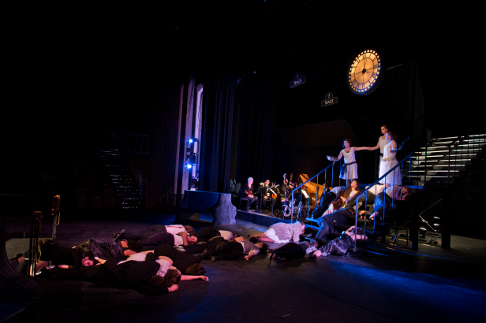 A scene from La Calisto – Simpson College [Photo by Luke Behaunek]
A scene from La Calisto – Simpson College [Photo by Luke Behaunek]
MN: What is your production of La Calisto like?
JNM: Our La Calisto is set in the glamorous era of the 1920s. All the gods have human characteristics and there is a great deal of gender bending. We set the action in a train station that becomes a nightclub. When the opera was performed at the Simpson College Theater, we placed Maestro Bernard McDonald’s orchestra in the center of the stage so that the musicians could be seen playing their period instruments. They were part of the nightclub, which was fun, too.
MN: What do you see yourself doing five or ten years from now?
JNM: I also have a degree in arts administration so I would like to be artistic director or advisor for a company, but I still want to design for other companies internationally. Next year I will do a show with Reisopera in co-production with Gotham Chamber Opera in Amsterdam and this summer I am going to the Castleton Festival.
MN: How do we assure the continuance of opera for generations to come?
JNM: There have been quite a few articles written saying that opera is dead in Boston. After reading three of them I became more than a little annoyed. I refuse to believe that opera is a dying art form. Although my studio is in New York, I have very close ties to Boston. I remembered that there was a New York Opera Party that brought all the city’s functioning companies together after the New York City Opera closed. Boston, too, needed to celebrate opera as a living art form. Last year I reached out to the artistic directors of its many companies and we had an exciting celebration with each company performing a song. Thus, we celebrated our rich and vast diversity within the opera world.
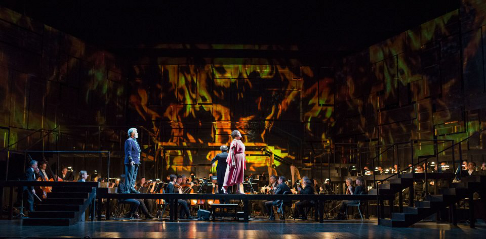 A scene from Bluebeard’s Castle – Opera Omaha [Photo by Jim Scholz]
A scene from Bluebeard’s Castle – Opera Omaha [Photo by Jim Scholz]
MN: What do you like best about designing for opera in the United States?
JNM: Many people have asked me why I live in the States and not in Europe. I believe that opera in the United States is on the verge of something very exciting. I think the art will reinvent itself because of its financial challenges. That scene will be very exciting for those of us who work in it.
When I did a Madama Butterfly in El Paso Texas I encountered a most amazing opera audience. The opera house is close to the border with Mexico. Standing in front of it I could watch the patrons walking across to the United States in their fancy opera clothes. I just loved seeing that.
MN: What kind of modern technology do you find most helpful?
JNM: I use every kind of technology that is available to me and appropriate to the piece. I love experimenting, too, but I know designers have to be careful that technology does not become a distraction. It has to help move the story along. When La Calisto was first staged, it had every possible bit of technology, but since then it has also been staged for smaller companies. Often they have lower budgets and we have to produce the same effects without using expensive tools. I do some shows on very large budgets and others on very tiny budgets. It’s the projects themselves and the possible collaborations with other artists that have to interest me, not the money involved.
Some aspects of opera in the United States are new already. I don’t think we could have had an Opera America Conference discussing site specific performance fifteen years ago. Boston Lyric and Long Beach Opera for example both perform in sites other than theaters. Seats have to be accessible and comfortable and site-specific opera is not necessarily cheap, either. We don’t have the usual theater infrastructure, so we have to make everything we need and we have to worry about sound balance. I love doing it, however, because it is an exciting challenge.
MN: Do you teach?
JNM: I would like to teach more and transmit the approaches that I have developed and the “Opera World” that I love to the next generation. However, I travel a lot and to be fair to my students, I only give guest lectures and take interns for the moment.
MN: What do you like best about designing?
JNM: I love making the audience an integral part of the show. We must remember that when most operas were new, the art and the chandeliers in the opera houses were new, too. I like to immerse the audience in the world of the opera being played. One way of doing that is by inviting artists to do installations in or around the theater. When I did Bluebeard’s Castle at Opera Omaha we had three hundred twenty doors on stage as well as a very large orchestra. The castle wrapped around the orchestra so that it appeared to be inside the building.
Opera Omaha General Director Roger Weitz brings his audience many new ways to look at opera, including new singers and new directors. Happily, he has an audience that accepts new ideas. Of course, he also stages wonderful traditional performances. Most importantly, his audience trusts him to bring them quality shows. The relationship a company has with its audience really helps the art form grow. I should also point out that the kind of brand building based on the artistic product and achievements such as producer Beth Morrison’s successes in New York, Los Angeles, and elsewhere, brings engaged audiences to the theater.
image=http://www.operatoday.com/Julia_Noulin-Merat.png image_description=Julia Noulin-Mérat [Photo © Steven Meyer] product=yes product_title=A Chat with Julia Noulin-Mérat product_by=An interview by Maria Nockin product_id=Above: Julia Noulin-Mérat [Photo © Steven Meyer]Madame Butterfly, Royal Opera
If Puccini’s aim was — in keeping with verismo ideology — to portray the grim reality of contemporary life then the story of Cio-Cio-San’s exploitation, abandonment and self-sacrifice must have seemed a fitting tale. John Luther Long’s eponymous short story — which since its 1904 publication has spawned many a Butterfly-derivation — was based on a real-life incident: here, then, was the opportunity for the composer to depict the catastrophic actualities of cultural and sexual exploitation amid human suffering, gritty pragmatism and stoic self-sacrifice in back-street Nagasaki.
However, Puccini was evidently more interested in verismo settings than its aesthetics and philosophies: perhaps the only ‘genuine’ verismo operas are Il Tabarro and Tosca, for even in La Bohème the emphasis is more on the captivating bohemian milieu than the sordid quotidian affairs of the common man and woman. The garrets of the nineteenth-century Quartier Latin may have posed as present-day normality but in fact they were just as remote and picturesque as the faraway harbour-shores of Nagasaki.
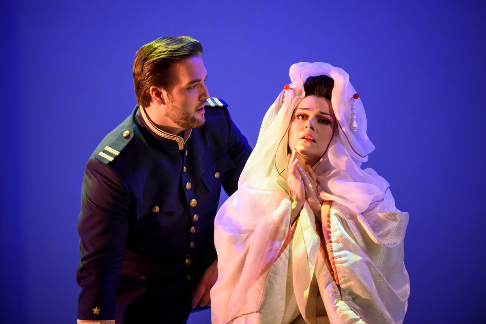 Brian Jagde as Lieutenant B.F. Pinkerton and Kristine Opolais as Cio-Cio-San
Brian Jagde as Lieutenant B.F. Pinkerton and Kristine Opolais as Cio-Cio-San
Thus, Madame Butterfly is less an exposure of racial, financial and sexual abuse than a tale of love, sacrifice and redemption — and one not so far from the ideals of German Romanticism. Puccini may have called Madame Butterfly a ‘tragedia giapponese’ but it is not Japanese in any naturalistic sense: indeed the French term Japonisme might be nearer to the mark, referring as it does to the mania for the East which followed the end of Japanese isolation from the West in 1854. In the pavilions of the world fairs held in Paris during the late-nineteenth century, the Occident discovered the Orient through displays of the latter’s art, plays and music — and it devoured what it saw.
This infatuation is thrillingly reflected in Christian Fenouillat’s subtle but penetrating set designs and the wildly glowing colours of Christophe Forey’s lighting scheme: Puccini’s orientalism is exotic mystery rather than naturalistic misery. So, Fenouillat presents us with a room whoseshoji screens decorously rise and slide to reveal glimpses of Nagasaki — a pale view of the hills — or an ornamental shūyū, the blue-pink mist which hazily bathes the ornamental garden making a fairy-tale of Butterfly’s entrance. These screens allow rays of yellow-green or orange light to slide across the set floor, emphasising the unfamiliar perspective of the world we view. It will not reveal all its secrets or admit interlopers: Kate Pinkerton appears first as a silhouette, ominous and alien, through the dividing screen. And, the flat backgrounds cut off figures and sakura trees at the edge of the frame; this is an asymmetrical world of juxtaposed angles, layers and colours. Japanese cherry blossom trees are traditionally associated with clouds, because of their weightless flowery mass, and when the ephemeral petals tumble to the floor at the end of Act 3, illumined by a ghostly moon-glow, the death of Butterfly’s airy dreams is painfully apparent.
All this beauty and symbolism might be mere superficial satisfaction for one’s sensibilities, if it were not for the dramatic insight and vocal distinction of Latvian soprano Kristine Opolais who truly appreciates, and communicates, that Butterfly’s tragedy is a personal one not a cultural one. Opolais may not convince as an ingénue or a teenage Geisha: she is too tall and her voice too sophisticated and knowingly mature to encapsulate the girlish immaturities of a giggling fifteen-year-old. But, her Butterfly is a ‘real’ woman of disturbing integrity and resolution, and this steely determination is gradually revealed by Opolais to be an unwavering willpower and honesty which will eventually destroy both herself and Pinkerton.
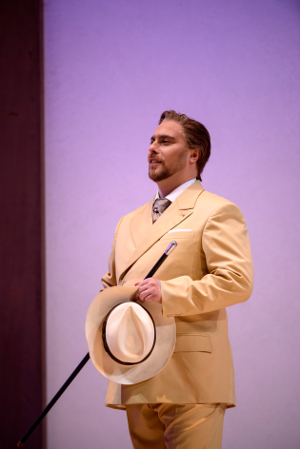 Gabriele Viviani as Sharpless
Gabriele Viviani as Sharpless
Opolais’s spinto glistens like gossamer thread but has an underlying strength; she sang with such seductive lyricism that, for once, one might empathise with Pinkerton’s infatuation. Her voice is not huge, though, and there were some places where it was overshadowed by the orchestral fabric; but, in the end-of-Act 1 love duet Opolais used a powerful chest voice to convey the shockingly deep passion which lays beneath her docile purity and the demure civilities of her culture.
In Act 2 she laid bare Butterfly’s emotional unpredictability: her haughty sulkiness when admonished or guided by Suzuki; her youthful excitability which irrepressibly bursts out, interrupting Sharpless’s reading of Pinkerton’s letter; her fiery anger when the US consul dares to suggest that she may never see Pinkerton again. In a pre-production interview in the Daily Telegraph Opolais said of the role: ‘Just to sing it with a good voice is not enough, it asks tears from your soul. I am very emotional on stage and the music is so tender that I suffer for real when I am singing it.’ This was nowhere more evident than in ‘Un bel dì’ where the wistful honesty of her singing totally explicitly and uncompromisingly revealed her despair.
Leiser and Caurier manage to keep their production on the right side of sentimentality, but here it was Opolais who imbued it with true tragic authority. It was a pity then that her final death throes were exaggerated and unconvincing: Butterfly’s destiny has been foreshadowed, for example in her prostrate figure at the close of Act 1, and once the ornate tantō has done its fatal work, one might have hoped for a less melodramatic physical collapse to convey Butterfly’s ultimately destructive passivity.
Opolais is well-partnered by Brian Jagde’s Pinkerton. The American tenor’s interpretation of the Yankee Lieutenant as an insensitive young buck whose crime is carelessness rather than malice is convincing, even if it doesn’t allow for much emotional range. Jadge’s tenor is bright and powerful, and although there were a few over-reaching rasps in Act 1, his aria, ‘Addio fiorito asil’, was deeply moving, full of shame and sorrow.
The rest of the cast were solid but somewhat overshadowed by Opolais’s intensity. Albanian mezzo-soprano Enkelejda Shkosa was a feisty Suzuki, strong and rich of voice, and Jeremy White’s white-faced Bonze cursed chillingly. Gabriele Viviani made a fairly bland impact as Sharpless, but Carlo Bosi’s Goro was wily and snakily persistent and the Italian tenor grabbed his dramatic moments.
The single performer who matched Opolais’s fearless commitment was conductor Nicola Luisottiwho drew incredible incisive playing from the pit, alternating searing, fervent climaxes — the instrumental introduction did not waste any time in setting out Luisotti’s intentions — with moments of pristine tenderness. Together with Opolais, Luisotti conveyed an essential truth: that Butterfly’s tragedy is not caused by external forces of pillage and corruption but derives from within, from her own misplaced love.
Claire Seymour
Cast and production information:
Cio-Cio-San, Kristine Opolais; Pinkerton, Brian Jagde; Sharpless, Gabriele Viviani; Goro, Carlo Bosi; Suzuki, Enkelejda Shkosa; Bonze, Jeremy White; Yamadori, Yuriy Yurchuk; Imperial Commissioner Samuel Dale Johnson; Kate Pinkerton, Anush Hovhannisyan; Conductor, Nicola Luisotti; Directors Moshe Leiser and Patrice Caurier; Set designs, Christian Fenouillat; Costume designs, Agostino Cavalca; Lighting design, Christophe Forey; Orchestra and Chorus of the Royal Opera House. Royal Opera House, Covent Garden, London, Friday 20th March 2015.
image=http://www.operatoday.com/%C2%A9BC20150317_Madama_Butterfly_RO_817%20ENKELEJDA%20SHKOSA%20AS%20SUZUKI%2C%20KRISTINE%20OPOLAIS%20AS%20CIO-CIO-SAN%20%28C%29%20ROH.%20PHOTOGRAPHER%20BILL%20COOPER.png image_description=Enkelejda Shkosa as Suzuki and Kristine Opolais as Cio-Cio-San [Photo © ROH. Photographer Bill Cooper. product=yes product_title=Giacomo Puccini: Madame Butterfly product_by=A review by Claire Seymour product_id=Above: Enkelejda Shkosa as Suzuki and Kristine Opolais as Cio-Cio-SanPhotos © ROH. Photographer Bill Cooper.
March 21, 2015
Tosca in Marseille
The recent, misguided Pierre Audi production at the Opéra de Paris is an example. Despite its slick “look” it was no more than the emperor in new clothes. But maybe you made your way to Marseille last week where the new production (sets/costumes/stage direction) by Louis Désiré restored your faith in revisionist productions. And in Tosca.
It was not a cast of singers in Marseille that limited its sights to the verismo thrills perpetrated by larger than life opera singers and effect mongering conductors. It was a cast that immersed itself in a revision of Tosca. No longer a mere showpiece for powerful singers of powerful personality the opera had become true theater where every word was eloquent and every gesture carved — a revisionist Tosca if there ever was one.
Director Désiré imagined Puccini’s “shabby little shocker” in a shadowy atmosphere that bespoke the prevailing dangerous political climate in which corrupt power, jealousy and unfettered lust exploded into lurid happenings. The production was in fact a study in chiaroscuro — fields of darkness with shafts of yellow light at the precise moments when emotions flared.
Lighting the singers will have been a monumental task, not only for the very accomplished lighting designer Patrick Méeüs, but also for the actors to learn where and when to move into and out of the shafts of light (note that Mr. Méeüs primarily designs lighting for dance where directional lighting techniques are highly developed).
Marseille born Louis Désiré maybe began his career as a costume designer or maybe as a set designer (the program bio is unclear). As both he is known to American audiences as a collaborator of American director Francesco Negrin (Werther in San Francisco and Rinaldo in Chicago).
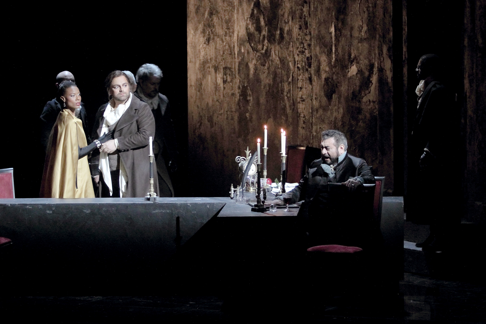 Adina Aaron as Tosca, Giorgio Berrugi as Cavaradossi, Carlos Almaguer as Scarpia
Adina Aaron as Tosca, Giorgio Berrugi as Cavaradossi, Carlos Almaguer as Scarpia
As the sole metteur en scène of this Tosca he created stage pictures that are the highly charged personal moments of Mannerist painting — to be clear, it is the moment he captures, not the action. In fact his staging is two dimensional tableaux, occurring with few exceptions within the proscenium frame. He uses clever techniques to reduce this larger frame — for example Scarpia’s Act II table is a long black quadrangle box extending across half the stage, when actors move behind it there lower bodies are hidden, thus a sort close-up is effected.
The large proscenium frame of course was completely filled for the Scarpia “Te Deum.” There was no procession, only Scarpia standing downstage center holding one of the roses Tosca had placed on the altar to the Virgin Mary. Behind him in two straight, across the stage lines were 48 black cossack covered Opéra de Marseille choristers whose arms rose in celestial rapture to Scarpia’s sexual raptures. It was good, very, very good.
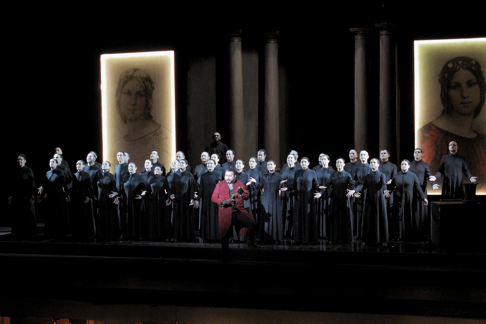
Scarpia’s apartment boasted a small balcony on the side where Tosca escaped to sing her “Vissi d’arte” in a shaft of light, her lower body hidden by the railing. These tableau moments told the sordid tale from beginning to end in a seemingly inexhaustible catalogue of Mannerist inspired poses, epitomized by the execution — Cavaradossi was alone downstage center, the revolving stage had removed the shooters from the frame, Tosca was hidden behind a wall).
American soprano Adina Aaron, dressed the entire opera in an unadorned straight line gold gown (like a shaft of light), created an exotic presence for the actress Floria Tosca, her dark hued voice producing a lovely, burnished spinto tone, her less-than-full-throated high climaxes absorbed into the musicality of her character. She closed Act II sitting alone down stage center, flanked by two candles to speak Tosca’s “davanti lui tutta Roma tremava.” Delivered with resigned irony the tableau was simply an ironic statement of the line we had been waiting for.
Italian tenor Giorgio Berrugi sang Cavaradossi with exquisite musicality, all famous Italian tenor mannerisms firmly present but impeccably integrated musically. His ease of vocal production in this spinto role made his character about musical line, integrating his music into Puccini’s high octane drama in a flow that supported Mr. Désiré’s flow of tableaux. Of very great pleasure was the dramatic and musical authenticity of his rolled “r”‘s, creating unexpected ornamentation.
Mexican baritone Carlos Almaguer roared with unfettered gusto, as must every Scarpia. In this staging he is not asked to be emotionally complex but simply to reign as the perpetrator of the darkness of Napoleonic political atmospheres. Here he did not complicate his basically gruff delivery with nuance, nor did he attempt to assume an out-sized presence. He underscored director Désiré’s Tosca as a straight forward, uncomplicated recounting of the facts of the story. That he waited until the final curtain calls to take his bow assured the dramatic integrity of the production.
Of note as well was the excellent Angelotti of French bass Antoine Garcin, for once a consul of the fallen Italian republic who showed requisite age and stature.
Italian conductor Fabrizio Maria Carminati sacrificed the showy, obvious effects of this warhorse opera to the far more subtle demands of the production. It is the mark of a real opera conductor to integrate the score into the production. We can be very grateful to Mo. Carminati for the unobtrusive and very able contribution of the pit.
As metteur en scène Mr. Désiré both designs and stages Carmen for the Chorégies d’Orange this summer, with lighting by Patrick Méeüs. Not to be missed (cherries-atop-the-cake: Kate Aldridge as Carmen, Jonas Kaufmann as Jose).
Michael Milenski
Cast and production information:
Floria Tosca: Adina Aaron: Mario Cavaradossi: Giorgio Berrugi; Scarpia: Carlos Almaguer; Le Sacristain: Jacques Calatayud; Angelotti: Antoine Garcin; Spoletta: Loïc Felix; Sciarrone: Jean-Marie Delpas; Le Pâtre: Jessica Murrolo. Orchestre et Chœur de l'Opéra de Marseille. Conductor: Fabrizio Maria Carminati; Mise en scène / Décors / Costumes; Louis Désiré; Lighting: Patrick Méeüs. Opéra de Marseille, March 18, 2015.
image=http://www.operatoday.com/Tosca_Marseille1.png
image_description=Photo by Christian Dresse courtesy of the Opéra de Marseille
product=yes
product_title=Tosca in Marseille
product_by=A review by Michael Milenski
product_id=Above: Adina Aaron as Tosca, Giorgio Berrugi as Cavaradossi
Photos by Christian Dresse courtesy of the Opéra de Marseille
March 20, 2015
Poetry beyond words — Nash Ensemble, Wigmore Hall
Ostensibly, the concert featured some of the best modern British composers, plus Elliott Carter, an honorary Brit, since his music has been so passionately championed in this country.
But a deeper perusal of the programme revealed even greater depths.. “Poetry beyond Words” I thought, since most of the pieces transformed their original sources in text and visual images into exquisitely original works of art. Lieder ohne Worte: an affirmation of the life force that is creativity.
Simon Holt’s Shadow Realm (1983) gets its title from a poem by Magnus Enzensberger (a favourite of Hans Werner Henze). “.....for a while/ i step out of my shadow/for a while.....”. Holt’s music penetrates the elusive mysteries of the text, going beyond the words to express its spirit. It’s structured in two halves, “shadowing” one another, but scored for an unusual combination of clarinet, harp and cello, creating a three-way conversation, creating a further shadow around the duality of its conception. It’s a miniature, only eight minutes long, but its concision is so elegant that it puts to shame many works which drown in verbose meandering. Holt was only 25 when it was written: a remarkable original achievement by a composer whose self-effacing manner belies a mind of great originality. It says much about the Nash Ensemble that they commissioned it, long before Holt became famous.
The poems of Lorine Neidecker (1903-1970) pack intense meaning into fragmentary, haiku-like lines, some of which don’t even follow grammatical syntax. But therein lies their beauty. Harrison Birtwistle’s Nine Settings of Lorine Niedecker (1998-2000), another Nash commission, distills each poem with a kind of almost homeopathic concentration, communicating the spirit of the poems, far more creatively than mere word-painting. Claire Booth sings arching lines which reach upwards and outwards, sustaining the legato, while the cello weaves around, without interruption, coming into its own only when the voice falls silent, like an elusive echo, Eventually, the poems seem to move away, beyond human hearing. The music gradually slows down, voice and cello retreating together with melancholy “footsteps”, each note expressed with solemn dignity. Birtwistle recognizes the fundamental structure of Niedecker’s text, but emphasizing syllables and single words, rather than phrases. “ thru bird/start, wing/drip, weed/drift”, though in the text the words are joined. Perhaps this captures the sense of water, dripping quietly in some vast stillness. Yet it’s also typically Birtwistlean puzzle-making, creating patterns within patterns, layers within layers. Beautiful moments linger in the memory, like the “You, ah you, of mourning doves”, where the poet plays with the word “you”, which sounds like dove call yet also evokes human meaning, while the composer, for once, infuses the word “mourning” drawing its resonance out, like the cooing of the bird.
One of the great joys of Julian Anderson’s music is that he’s an extraordinarily visual composer. Graphic images inspire his music and enrich its interpretation. His Alhambra Fantasy (2000) was stimulated by Islamic architecture, The Book of Hours (2005) by the miniatures in Les Trés riches heures du Duc de Berry, and even Symphony (2003), despite its non-committal title, owes much to the paintings of Sibelius’s friend, Axel Gallen-Kallela. Yet again, the Nash Ensemble recognized his unique gift almost from the start. Poetry Nearing Silence (1997) was inspired by The Heart of a Humument, a book of paintings by Tom Phillips, where random words from an obscure novel were picked at random, then adventurously illustrated.
Just as Phillips transforms words into visuals, Anderson transforms ideas into abstract music. Eight highly individual segments unfold over 12 minutes. Each has a title, borrowed from the book, though the settings as such aren’t literal. In the third segment “my future as the star in a film of my room”, one of the violinists plays percussion (a ratchet), which whirrs like the cranking of an old-fashioned camera. In the Wigmore Hall, the sound is decidedly disturbing, but that’s perhaps Anderson’s intention : we can’t take what we hear for granted. In theory, the segments travel round Europe - Vienna, Bohemia, Carpathia, Paris. Far away landscapes of the imagination: perhaps we hear references to Janáček’s Sinfonietta, crazily buoyant but cheerful. The Nash play at being folk musicians, imitating alphorns and shepherd’s pipes. Everything in joyous transformation! Gradually, the clarinet (Richard Hosford) draws things together, as silence descends. Although Anderson doesn’t employ voice in this piece, it feels like song, because the orchestration has such personality.
The recital began with the world premiere of Richard Causton’s Piano Quintet (2015), dedicated to the Nash. It’s lively and inventive. Violins and viola tease cello and piano, provoking and taunting, whiling off in all directions. Gradually the piano (Tim Horton) restores harmony with a gracious cantilena. Peter Maxwell Davies’s String Quintet (2014) also received its world premiere. Four movements, each with a different mood and form, the Chacony being the most vivid. Before that, Elliott Carter’s Poems of Louis Zukofsky (2008), with Claire Booth and Richard Hosford. Carter expresses the shape of the poems as they are laid out in print. There are silences in poems which create an impact by the way they look on the page denser scoring where needed, the vocal line calling out into aural space. Zukofsky’s copyright holder issues stern warnings against quotation and use — a very different attitude to the immensely rewarding creative inter-relationship between different art forms that made this concert so rewarding.
If I haven’t written much about the performances, that’s because the Nash Ensemble are always good, and reliable. The players on this occasion were Tim Horton (piano), Philippa Davies (flute), Richard Hosford (clarinet), David Adams (violin), Michael Gurevich (violin), Lawrence Power (viola), James Boyd (violin), Björg Lewis (cello), Adrian Brendel (cello), Lucy Wakefield (harp) and Claire Booth (soprano), and Lionel Friend (conductor).
This concert was recorded for broadcast on BBC Radio 3 on 13th June 2015
Anne Ozorio
image=http://www.operatoday.com/nash_ensemble.png
image_description=The Nash Ensemble [Photo © Hanya Chlala/ArenaPAL]
product=yes
product_title= The Nash Ensemble 50th Anniversay, Wigmore Hall, London, 18th March 2015.
product_by=A review by Anne Ozorio
product_id=Above: The Nash Ensemble [Photo © Hanya Chlala/ArenaPAL]
March 19, 2015
Arizona Opera Presents Magritte Style Magic Flute
In 1790 and 1791, Emanuel Schikaneder produced a series of fairy-tale operas at the Theater auf der Wieden that culminated with the premiere of Die Zauberflöte (The Magic Flute) for which Wolfgang Amadeus Mozart wrote the music. Although Schikaneder probably wrote the libretto, Karl Ludwig Giesecke, the playwright he most often worked with, also claimed authorship. The writer based his text on earlier plays such as Sophie Seyler’s Oberon. By combining elements of Masonic ritual with fairy tale opera, the librettist created a fine musical work in which a clever artist could make good use of his abilities as a comedian and a singer. Although Mozart died shortly after its premiere, The Flute was a monumental success that was seen over a hundred times in the short space of a few months. Schikaneder wrote, “Mozart’s work is beyond all praise. One feels only too keenly, on hearing this or any other of his music, what the art has lost in him.”
On March 7, 2015, Arizona Opera presented Dan Rigazzi’s production of Die Zauberflöte in Tucson. Inspired by the works of René Magritte, designer John Pollard filled the stage with various sizes of picture frames, windows, and portals from which he leads us into Mozart and Schikaneder’s dream world. Costume Designer Leslie Bernstein’s clothing was timeless and opulent but she might have been wiser if she had avoided thinly veiled midriffs for singers because of their constant use of muscles in that area of the body.
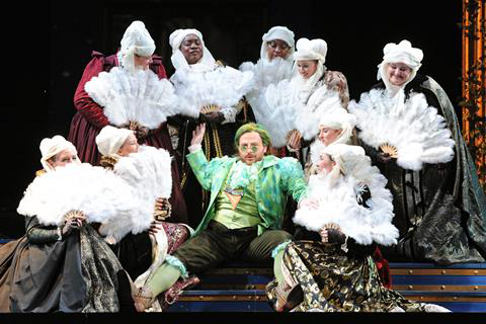 Chad Sloan as Papageno with chorus ladies
Chad Sloan as Papageno with chorus ladies
The star of the show was Marion Roose Pullin Studio Artist Sarah Tucker who sang Pamina. She has already been a Marcello Giordani Young Artist and Metropolitan Opera National Council 2014 Auditions semifinalist. Her voice was sweet and her high notes had a radiant bloom. David Margulis was an energetic Tamino who was only momentarily laid low by Pollard’s iconic monster. He sang with sumptuous lyrical sounds conveyed on a well-honed legato. Chad Sloan was a sparkling Papageno with a robust voice who never stopped moving. He made you believe he could easily capture the most elusive birds with his bare hands. As Papagena, the lover who does not appear until the last act, Rhea Miller sang with dulcet tones and showed a great deal of affection for the many children who magically appeared when the couple sang of their love.
The Three Ladies, soprano Andrea Shokery, along with mezzo-sopranos Beth Lytwynec and Maria Dominique Lopez, sang with limpid harmonies while taking advantage of every comedic possibility. As the Queen of the night, Lindsay Russell negotiated the highest notes with unusual security, blazed through its difficult runs, and gave her character understandable human traits. I couldn’t help wondering about the age-old question as to whether she had once been Sarastro’s lover! He hated her with more emotion than anyone would waste on a casual enemy! A fine bass, Nicholas Masters sang his character’s views passionately with robust bronze tonal colors.
Second year Studio Artist Calvin Griffin sang the Speaker and the lower-voiced Armed Man with stentorian tones. Ian McEuen was a thoroughly amusing Monostatos while Studio Artists Andrew Penning and Chris Carr were committed priests. Dressed in resplendent costumes, Henri Venanzi’s choristers combined visual spectacle with vocal acumen as they sang Mozart’s immortal harmonies. Scott Terrell’s conducting was generally brisk and he followed the singers, giving them the space they needed to form believable characters. Only on a few occasions did he slow down enough to slacken the tension for a moment or two of respite. We had a pleasant trip to Tucson and hearing the performance in a different hall provided an interesting contrast.
Maria Nockin
Cast and production information:
Tamino, David Margulis; Papageno, Chad Sloan; Pamina, Sarah Tucker; Queen of the Night, Lindsay Russell; First Lady Andrea Shokery; Second Lady, Beth Lytwynec; Third Lady, Maria Dominique Lopez; Sarastro, Nicholas Masters; Monostatos, Ian McEuen; Papagena, Rhea Miller; First Priest/Armored Man, Andrew Penning; Speaker/Second Armored Man, Calvin Griffin; Second Priest, Chris Carr; Spirits: Liam Boyd, Noah Sharma, Owen Lamb; Conductor, Scott Terrell; Stage Director, Dan Rigazzi; Scenic Designer, John Pollard, Lighting and Projection Designer, Douglas Provost; Chorus Master, Henri Venanzi.
image=http://www.operatoday.com/MagicFlute06.png
image_description=Lindsay Russell as The Queen of the Night announces her presence to David Margulis as Tamino [Photo by Tim Trumble]
product=yes
product_title=Arizona Opera Presents Magritte Style Magic Flute
product_by=A review by Maria Nockin
product_id=Above: Lindsay Russell as The Queen of the Night announces her presence to David Margulis as Tamino
Photos by Tim Trumble
March 18, 2015
Henry Purcell: A Retrospective
Over half of the works presented were selected from the ‘Gresham Manuscript’, a book of songs mostly scribed by Purcell’s own hand which was compiled between 1692 and 1695.
A facsimile of the manuscript was published in 1995, Purcell’s tercentenary year; as its editors, Margaret Laurie and Robert Thompson, explain in their Introduction: ‘The purpose of the book is not clear, some believe that it was for Purcell’s own use as a singer, while others hypothesize that it was a “pupil’s” volume.’ In his interesting programme article, Andrew Pinnock notes recent research by Thompson that suggests that the Gresham manuscript was copied for Purcell’s pupil, Lady Annabella Howard, maid of honour to Princess (later Queen) Anne; the latter was an accomplished harpsichord and guitar player, and Annabella would have been expected to entertain the princess and perform alongside her. Pinnock suggests that the manuscript is ‘an idiosyncratic anthology reflecting Annabella Howard’s musical personality, allowing her to display her skills in performance and providing practice material of the highest imaginable quality’.
The Gresham manuscript contains the opening six items from Purcell’s The Fairy-Queen, which Princess Anne saw in Dorset Garden theatre in 1692; and it was with three numbers from this semi-opera that the recital began. ‘Come all ye songsters’ is a light dance for Titania’s revelling fairies, and Sampson’s pristine brightness and open sound affectionately evoked the sprites’ joyful merry-making. The busy accompanying textures of Elizabeth Kenny’s lute, Jonathan Manson’s bass viol and Laurence Cummings’ harpsichord added to the high spirits. In the instrumental playout of ‘Sing while we trip it’ each of the three accompaniments took primacy in turn, courteously passing on the musical baton with the courtly decorum suggested by the text, ‘Sing while we trip it upon the green; … Nothing offend our fairy Queen’. Sampson spun beautiful melodic arcs in ‘Ye gentle spirits of the air’, and the sunny repetitions of ‘appear, appear’ together with an enticing melisma, ‘Prepare’, would sure have tempted the spirits to ‘join your tender voices here’. The soprano demonstrated a relaxed flexibility and a warm lower voice, while her upper range carried beautifully.
The sparser accompaniment offered by Kenny’s lone theorbo highlighted the decorative melodic shapes of the opening lines of ‘The cares of lovers’ (from Timothy of Athens). Sampson summoned a vocal rhetoric to complement the subtle oppositions of major/minor tonalities, and was able to draw upon her varied palette of hues and excellent breath control to convey the erotic inferences of the text, ‘So soft, so gentle is their pain, ’Tis even a pleasure to complain.’ The vocal passagework and scuttling accompaniment at the start of ‘Fly swift, ye hours’ was clean and precise; but as the song expanded into a ‘mini-cantata’, Sampson deepened the dramatic intensity, bringing fervency to the poet’s plea to ‘Bring back my Belvidera’. The arioso section ‘Swifter than Time’ had a sweet lilt, but the recitative, ‘Soft peace is banish’d’, summoned great anguish. Sampson’s unhurried chromatic falls were perfectly tuned and the languid melismas exquisitely sighed. The sinking register of the final line evoked the poignancy of the poet’s pain as he ‘embrace[s] my chain’.
The florid anger of ‘Not all my torments’ shook us from our quiet reflections, while ‘From rosy bow’rs (from Don Quixote) thrilled with its unpredictability, sudden injections of pace and colour conjuring the cunning, feigned madness of Altsidora who tries, by presenting herself as a woman possessed by a frenzied passion, to lure Don Quixote from his beloved Dulcinea. Again, Sampson exercised masterly control over the song’s changeable rhetoric, by turns still then driven, accelerating towards the close with wild excitement. After the interval, ‘Let the dreadful Engines of Eternal Will’ from the same work similarly confirmed the soprano’s innate, well-judged theatricality, as she convincingly embraced the declamatory freedom of the music which shifts between arioso and recitative, intensifying the harmonic twists which evoke the mood swings of Cardenio, who has been deserted by Luscinda.
The light leaps of ‘I see she flies me’ ran on into the lamenting sighs of ‘What a sad fate is mine’. The ground bass of the latter was hypnotically entrancing, enhanced by delicate ornamentation and wonderfully expressive of the forsaken poet’s dilemma: ‘’Tis all I implore,/ To make me love less,/ Or her to love more.’ In ‘’Tis Nature’s Voice’ (from Hail, Bright Cecilia) Sampson showed how she could deepen the weight of her lower register and she used the chromatic contortions of the melismatic vocal line to express the power of the ‘mighty Art’ of music which ‘charms the Sense and captivates the Mind’. ‘Lucinda is bewitching fair’ (from Abdelazar, or The Moor’s Revenge) was free and full of declamatory vigour.
Instrumental pieces were interspersed between the vocal items. Purcell’s C major harpsichord suite was played by Cummings with delicate restraint: the initial simple-two part textures were lucid, while the bass line in subsequent more complex movements was used effectively to provide direction, and there were some engaging rhythmic emphases in the concluding jig. Kenny alternated dryness and richness in numbers from Princess Anne’s guitar book. And, there was music from Purcell’s contemporaries too: Giovanni Battista Draghi’s ‘Italian Ground’ was impressively played by Jonathan Manson, his bass viol strumming airily then crooning melodiously, while Kenny sustained the upper line of Francesco Corbetta’s Passacaille with salient limpidity.
We ended where we began, with The Fairy Queen, as Sampson entreated us to harken the ‘echoing air’. The text, as with many of these songs, is fairly mundane: ‘Hark! hark, the ech’ing air a triumph sings,/ And all around, pleased Cupids clap their wings.’ But, Purcell was equally inspired whether setting the words of the greatest poets of the day — Dryden, Congreve — or a banal ditty. Sampson sometimes promoted the beauty of sound and grace of line over the clarity of the text: for example, the consonants were lost in the rapid repetitions and scotch-snaps of ‘Sing while we trip it’, and blurred by the assonance of ‘Let the dreadful Engines’ — frequently I found myself having to follow or check the text in the programme.
But, an occasional clouding of the diction did not make this recital any less beguiling, and the bewitchment continued beyond the concluding song of the programme, with two encores — ‘I attempt from love's sickness’ and ‘Fairest Isle’ — of artless magic.
Claire Seymour
Performers and programme:
Carolyn Sampson, soprano; Elizabeth Kenny, lute; Jonathan Manson, bass viol; Laurence Cummings, harpsichord. Wigmore Hall, London, Tuesday 17th March 2015.
Henry Purcell — The Fairy Queen : ‘Come all ye songsters of the sky’, ‘Sing while we trip it on the green’, ‘Ye gentle spirits of the air appear’; The History of Timon of Athens: ‘The cares of lovers’; ‘Fly swift, ye hours’; ‘Not all my torments can your pity move’; The Comical History of Don Quixote: ‘From rosy bow'rs’, ‘Let the dreadful engines’; Aureng-Zebe, or The Great Mogul: ‘I see she flies me’; ‘What a sad fate is mine’; ‘Pious Celinda goes to prayers’; ‘Hail, bright Cecilia’; ‘’Tis Nature's Voice; thro' all the moving Wood’; Abdelazar, or The Moor’s Revenge: ‘Lucinda is bewitching fair’; The Fairy Queen: ‘Hark the ech’ing air!’
image=http://www.operatoday.com/carolyn_sampson.jpg image_description=Carolyn Sampson product=yes product_title=Henry Purcell: A Retrospective — Come All Ye Songsters product_by=A review by Claire Seymour product_id=Above: Carolyn SampsonMarch 14, 2015
Haydn’s Die Jahreszeiten in Istanbul
By Robert Hugill [Planet Hugill]
Joseph Haydn’s last oratorio Die Jahreszeiten (The Seasons) was conductor Sascha Goetzel's choice for the first oratorio performance by his Borusan Istanbul Phiharmonic Orchestra in the Istanbul Lütfi Kirdar ICEC on Thursday 12 March 2015. Goetzel and the orchestra were joined by soloists Miah Persson, Ian Bostridge and Duncan Rock, and the Salzburg Bach Choir.
Die Meistersinger and The Indian Queen
at the ENO
Sometimes you’ve got to get away to find a bit of sun, with good opera a bonus.
It was a brilliantly lighted afternoon making our way through Trafalgar Square on our way to the London Coliseum for the 3 PM curtain of Die Meistersinger, the winter hit of the ENO season. The production by British metteur en scène Richard Jones earned very positive review here on Opera Today, please see The Mastersingers of Nurenberg, as well as in the British press.
Of course it was no longer Die Meistersinger as it had been transformed into The Mastersingers of Nurenburg, and of course metteur en scène Richard Jones transformed Wagner’s noble, some may think pretentious tale of the glory of German art into a definitely unpretentious little story of cruelty to a silly old man (like in real comedy), though it was uncertain if the silly old man was Beckmesser — it might have been Hans Sachs). Like in real comedies true love prevailed, and that was enough to motivate Wagner’s mighty climax (abridged version) with just a tiny wink at German art — flash card faces at the very last moment (there had been a couple of hundred photos/drawings of German artists copied onto on the show curtain of which Jacques Offenbach was in bullseye position).
Like his staging of Ariodante in Aix last summer where the king of Scotland had become a mid-western American farmer, Mr. Jones miniaturized, indeed trivialized Meistersinger, here into a storybook tale. American designer Paul Steinberg created an almost children’s book setting. It was a mostly two dimensional scenic world of wallpaper-like repeating patterns in backdrops, the repetitive shapes echoed as well as in furniture and hand props. The second (riot) act was the intersection of two flat faced streets like classical Roman comedy, and the last scene (the competition) construed most of what we had already seen (props and drops) into grandiose, decidedly mock columns of imperial architecture.
The first scene (with the quintet) of the third act was, of course, the most rewarding. No longer the graphically flat public world of printed books it was the private world of Hans Sach exposed in the cluttered, not-for-public-view realism of a life that is not art, a flesh and blood life discovered in the midst of the artifice of witty and sophisticated design. In fact the quintet itself, surely meant by Wagner to be one of humankind’s greatest moments, stepped outside all scenic context, the singers lined across the stage in brilliant white light. Nothing else.
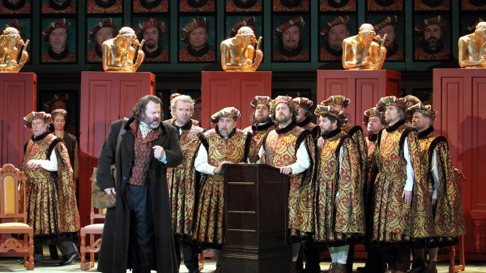 Gwyn Hughes Jones as Walther and the Mastersingers.
Gwyn Hughes Jones as Walther and the Mastersingers.
The use of the English language at ENO is very practiced, the diction nothing less than miraculous. The preciousness of the diction added a storybook, even infantile musicality that contributed greatly to Richard Jones’ fairytale, indeed satiric vision of what Mr. Jones, and we too might even perceive as Wagnerian bombast. It was this satire that brought honesty and perspective to this magnificent opera for us English speakers. Though maybe, finally, some of us missed the subtlety and gravity of the deeper reaches of Wagnerian thinking.
Back at Trafalgar Square a couple of days later the floating clouds of an ideal English skyscape prevailed during the day though heavy rains were predicted for the evening. The Peter Sellars production did rain heavy changes on Purcell’s 1695 "Dramatik Opera," The Indian Queen. Its original "Heroik Verse" by John Dryden washed away by Mr. Sellars’ Heroik Platitudes of Social Responsibility when not drowned in Down-With-White-European-Males syndrome.
The Indian Queen has not yet been reviewed on Opera Today.
There are those few of us who remember the 1998 Long Beach (CA) Opera production of The Indian Queen by Mexican performance artist Guillermo Gômez-Peña, the Dryden verse adapted to contemporary Chicano actors embodying the stereotypes that north-of-the-[Mexican]-border observers (cultural tourism) have imposed on south-of-the-border. However in the Peter Sellars production Dryden has been exiled from the Purcell intention.
Purcell’s piece does indeed cry out for racial and ethnic exoticism. In the Sellars production a Chicano actress from California narrated the ugly deeds of Dryden's Aztecs whom Sellars had transformed into Spanish conquistadors, manufacturing the evils they could have perpetrated on women and children. Note that this production has already been at Madrid’s Teatro Real where it certainly belongs — may the Spaniards expiate the sins of their past. It was a naive art, fish-out-of-water in London’s sophisticated theatrical world.
Peter Sellars has a fabulous, original theatrical mind and he is a great stage director. It was an evening of highest level theater, brilliantly conceived and realized starting with four dancers who were tirelessly choreographed into exotically titled dance sequences that added Mayan mysteries to Dryden's already absurd geography. Purcell's added Symphony, its parts titled Adagio, Allegro, etc., assumed names like “Dance of the Solar Fire Deities.” Note that a dramatik opera was like a French masque with recited words, instrumental music, airs and choruses, dances and of course spectacle.
Spectacle was created by Gronk [sic], the single named, Chicano artist/performance artist/etc who lives in downtown Los Angeles. He created paintings in the brilliant colors of exotic birds, industriously magnified into giant full stage drops or into large panels that could do all sorts of things like configure themselves into a Mayan temple from time to time. Sellars slickly incorporated this naive scenic art into the cult of talented, downtrodden but proud personalities that define his muse.
Cherry-atop-the-cake there was a signer [!] who stood in the baignoire next to the stage and signed the entire performance. You were not sure if this was for a disoriented deaf person who may have found himself in the Coliseum that evening, or to insist that the opposite of sound, excoriating evil in this case, is silence that simply ignores evil. Or what? It is a rich if silly image indeed. As well, both halves of the program culminated in silence, a quiet that endured naturally and decayed gradually. A coup de théâtre indeed before the delayed applause was heard. There were no individual bows taken beyond that of the conductor.
There are many of us who will argue that the ENO is the world’s finest opera company. Here the assembled cast was excellent (for the most part), polished singers of appropriate skin colors to sing the newly created words (Dryden was not at all in the picture). Well, except the conquistador replacing Dryden's Montezuma who was a black man. The orchestra boasted three theorbos, both a harpsichord and an portable organ in the sizable continuo, and a large number of modern and early music instruments for the larger orchestral pieces.
Most impressive of all was the ENO chorus, meticulously rehearsed into seemingly infinite colors and textures and volumes, the anti-war chorus that finalized the first act was positively shouted. The chorus had rushed onto the stage apron to confront us culpable white European males innocently sitting in the Coliseum auditorium.
The gentleman walking out of the auditorium ahead of me confessed to his friend that he had become hostile. So had I.
Michael Milenski
Casts and production information:
The Mastersingers of Nurenburg Walther: Gwyn Hughes Jones; Eva: Rachel Nicholls; Magdalene: Madeleine Shaw; David: Nicky Spence; Hans Sachs: Iain Paterson; Sixtus Beckmesser: Andrew Shore; Veit Pogner: James Creswell; Fritz Kothner: David Stout; Kunz Vogelgesang: Peter van Hulle; Konrad Nachtigall: Quentin Hayes; Ulrich Eisslinger: Timothy Robinson; Hermann Ortel: Nicholas Folwell; Balthasar Zorn: Richard Roberts; Augustin Moser: Stephen Rooke; Hans Folz: Roderick Earle; Hans Schwarz: Jonathan Lemalu; Night Watchman: Nicholas Crawley. Chorus and Orchestra of the English National Opera. Conductor: Edward Gardner; Producer: Richard Jones; Set designs: Paul Steinberg; Costumes: Buki Schiff; Lighting: Mimi Jordan Sherrin; Choreography: Lucy Burge. The London Coliseum, Saturday, March 7, 2015.
The Indian Queen Teculihuatzin/Doña Luisa: Julia Bullock; Doña Isabel: Lucy Crowe; Hunahpú: Vince Yi; Ixbalanqué: Anthony Roth Costanzo; Don Pedro de Alvarado: Noah Stewart; Don Pedrarias Dávila: Thomas Walker; Sacerdote: Maya Luthando Qave; Leonor: Maritxell Carrero. Chorus and Orchestra of the English National Opera. Conductor: Laurence Cummings; Director: Peter Sellars; Set Designer: Gronk; Costume Designer: Dunya Ramicova; Lighting Designer: James F. Ingalls; Choreographer: Christopher Williams. Libretto: Songs and hymns by Purcell, with texts by Katherine Philips, George Herbert et al. Spoken texts by Rosario Aguilar from The Lost Chronicles of Terra Firma. London Coliseum, March 9, 2015.
image=http://www.operatoday.com/Queen_ENO1.png
product=yes
product_title=Die Meistersinger and The Indian Queen at the English National Opera
product_by=A review by Michael Milenski
product_id=Above: Lucy Crowe as Doña Isabel, Julia Bullock as The Indian Queen [All photos from the ENO]
March 11, 2015
Rise and Fall of the City of Mahagonny, Royal Opera
The unresolved tension, much of it fruitful, some of it perhaps less so, between Brecht and Weill, came through loud and clear in this estimable performance, given in a new translation by Jeremy Sams (which was certainly preferable to his ‘versions’ of Mozart, even if not entirely free of the translator’s habit of drawing attention to himself rather than to the work). Is it an opera? Yes, of course. As David Drew pointed out long ago, in a 1963 Musical Times article, one of the most pernicious ideas about Mahagonny has been ‘one that menaces even the most generous-hearted listener — the idea that Weill intended the work as an attack on the body of the operatic convention by means of parody or an injected virus (jazz, cabaret etc.). This idea is wholly false.’ As Drew continued, Weill had far too much knowledge of and respect for the operatic repertoire, above all Mozart, but others too (not least, and ominously for his collaboration with Brecht, Wagner), but he was also genuinely excited by the new paths opened up by composers such as Janáček and Stravinsky. (He was also a great defender of Wozzeck.) The problem, for me, is that sometimes, though not always, the musical material does not present the composer at his strongest; in general, and despite the songs and tunes we know and love, I find him the more compelling the closer he comes to his time with Busoni. The Second Symphony and Violin Concerto are surely his masterpieces. Mahagonny’s music, however, remains on an entirely different level from Weill’s disappointing music for the United States. (Whatever his apologists may claim, that is surely, in aesthetic terms at least, where he ‘sold out’.)
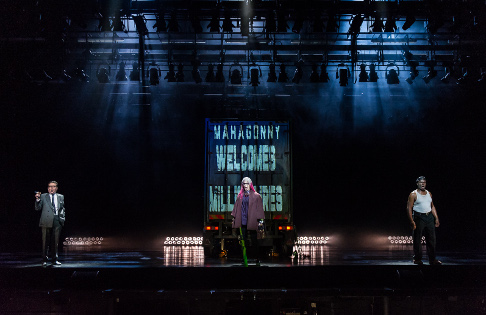 Peter Hoare as Fatty; Anne Sofie von Otter as Leocadia Begbick; Willard W. White as Trinity Moses
Peter Hoare as Fatty; Anne Sofie von Otter as Leocadia Begbick; Willard W. White as Trinity Moses
The greater problem still, though, lies in the collaboration with Brecht, whose strengths are quite different, and whose adamant refusal to sentimentalise may sometimes be undone by Weill. (Not that Weill is sentimental as such, but his æsthetic is undoubtedly different, less didactic, unquestionably less concerned with alienation, more concerned perhaps with ‘opera’). It is no mean achievement of John Fulljames’s production of this difficult, perhaps impossible, work, that Brecht’s stature as, after Beckett, perhaps the greatest of twentieth-century playwrights comes across with increasing immediacy. There is no attempt to make us ‘sympathise’, although Weill sometimes does not help in that respect. The conceit, as with that of the work itself, is admirably simple, though certainly not simplistic. Mahagonny and Mahagonny grow from a splendidly designed lorry. The accoutrements of capital, of ‘entertainment’, of neo-liberal barbarism sprout necessarily: garishly, of course, but retaining focus. Voice-overs and video projections do excellent work, Brecht’s placards reimagined for our computer-screen-obsessed age. Perhaps the acting does not always convince as strongly as it might as acting, but that is part of the trade-off between Brecht and Weill: an immanent criticism as much as, perhaps more than, a shortcoming. Choreography is sharp and to the point, for instance during the ‘Mandalay Song’, as the men of Mahagonny — and what an indictment for us this is of male behaviour, the Widow Begbick notwithstanding! — await their turn with the prostitutes. I wondered whether the Christ-like imagery at the end was exaggerated, but to be fair, it is no more so than it is in the work. Besides, we are at liberty to interpret God’s coming to Mahagonny as we will.
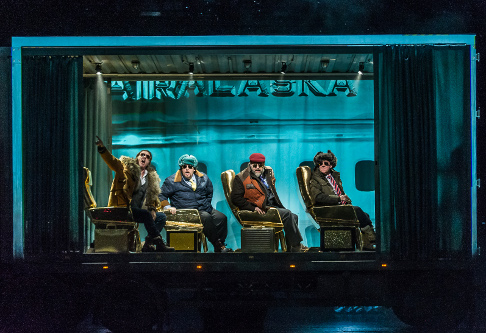 Kurt Streit as Jimmy Macintyre; Jeffrey Lloyd-Roberts as Jack O’Brien; Darren Jeffery as Bank Account Bill; and Neal Davies as Alaska Wolf Joe
Kurt Streit as Jimmy Macintyre; Jeffrey Lloyd-Roberts as Jack O’Brien; Darren Jeffery as Bank Account Bill; and Neal Davies as Alaska Wolf Joe
For, in general, the action is non-specific enough for us to be able to relate it to when and where seems most appropriate. (It would surely be bizarre, if in our age of bankster-crime run truly riot, we did not think of our own characters such as HSBC’s The Revd Prebendary Baron Green of Hurstpierpoint, surely an invention who would have been too much, too far-fetched, too agitprop, even for Brecht.) Price variations do their evil work, and Fulljames, whilst not entirely ignoring the ‘American’ element, does not overplay it. Weill was certainly alert to the danger of the work seeming as if it were too much ‘about’ America, writing to his publisher: ‘The use of American names for Mahagonny runs the risk of establishing a wholly false idea of Americanism, Wildwest, of such like. I am very glad that, together with Brecht, I have now found a very convenient solution … and I ask you to include the following notice in the piano score and libretto,’ although, oddly, it would only appear in the full score, not in the piano score: ‘“In view of the fact that those amusements of man which can be had for money are always and everywhere exactly the same, and because the Amusement-Town of Mahagonny is thus international in the widest sense, the names of the leading characters can be changed into customary forms at any given time. The following names are therefore recommended for German performances: Willy (for Fatty), Johann Ackermann (for Jim), Jakob Schmidt (for Jack O’Brien) [etc.]”.’ In an English-language version, we necessarily tilt more towards Americana — the exhibitionist piano-playing of Robert Clark is an especial joy! — but not too much. Moreover, whilst those of us with Lotte Lenya in our mind’s ear, may miss her and the rest of the Wilhelm Bruckner-Rüggeberg crew, we know that this is not a work to be confined to nostalgic conceptions of Weimar culture.
Mark Wigglesworth is surely one of our most underrated conductors, although let us hope his forthcoming tenure at ENO will change that; he conducted a punchy, intelligently varied account. If I found the ‘Alabama Song’ a little on the slow side, it was slow rather than sentimentalised. Weill’s Neue Sachlichkeit generally won through, and where more typical ‘operatic’ impulses threatened Brecht’s conception, that suggested its own humane rewards. Choral singing was well-drilled and not without ‘expressive’ quality: never too much, though. The chorales did their formal, almost Stravinskian (think not least of The Soldier’s Tale) work, reacting both with ‘tradition’ and with Brecht. There was certainly a characterful, properly parodic sense of what Drew, in that Musical Times article, called ‘the fairground banalities of the trial scene,’ likewise of the horrifying ‘stormtrooper tunes of the boxing scene’. Where, though, was the Crane Song? Everything is permitted, of course, its omission certainly so, but it seemed a pity. We should at any rate be grateful that the once-popular ‘Paris version’, a travesty, with no warrant from Weill, in which songs from the Songspiel were interspersed with a few instrumental pieces from the opera, is no longer favoured.
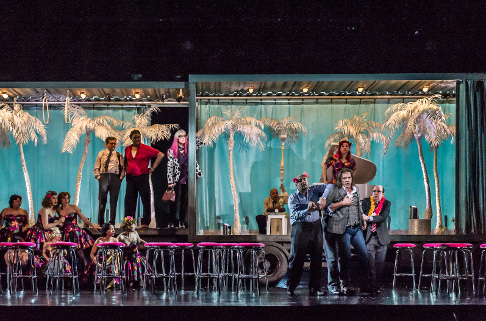 Peter Hoare as Fatty; Willard W. White as Trinity Moses; Anne Sofie von Otter as Leocadia Begbick; Jeffrey Lloyd-Roberts as Jack O’Brien; Christine Rice as Jenny; Kurt Streit as Jimmy Mcintyre; Neal Davies as Alaska Wolf Joe
Peter Hoare as Fatty; Willard W. White as Trinity Moses; Anne Sofie von Otter as Leocadia Begbick; Jeffrey Lloyd-Roberts as Jack O’Brien; Christine Rice as Jenny; Kurt Streit as Jimmy Mcintyre; Neal Davies as Alaska Wolf Joe
The tension between Brecht and Weill was perhaps most clear in the vocal performances. How to approach these roles as opera singers, in so large a theatre? For the most part, the cast coped well enough; if their performances fell somewhat uneasily between (at least) two stools, then perhaps that is unavoidable in a presentation of the work so conceived. Willard White balanced gravity and sleaze as Trinity Moses. Kurt Streit as Jimmy had his lyrical moments — but also, alas, his moments of would-be lyricism. Christine Rice’s Jenny veered uneasily between home-spun Oklahoma and operatic vibrato, but her transformations were not so blatant as those of Anne Sofie von Otter’s Widow Begbick. Stylistically, she was all over the place, but I assume that in some sense was the point. In any case, the whole, as the cliché has it, was more than the sum of its parts.
At the time of its first performance, Adorno’s was one of the few critical voices raised in favour of the work: ‘Apart from the diametrically opposed operas of the Schoenberg school, I know of no work better or more strongly in keeping with the idea of the avant-garde than Mahagonny … Despite and on account of the primitive façade, it must be counted among the most difficult works of today.’ That difficulty may have lessened, as indeed has that of Wozzeck or Von heute auf morgen — now when shall we see that in London? — but it remains, the chill with which Brecht and Weill react against each other perhaps no less than ever.
Mark Berry
Cast and production information:
Leocadia Begbick: Anne Sofie von Otter; Fatty: Peter Hoare; Trinity Moses: Sir Willard W. White; Jenny: Christine Rice; Six Girls: Anna Burford, Lauren Fagan, Anush Hovhannisyan, Stephanie Marshall, Meeta Ravel, Harriet Williams; Jimmy McIntyre: Kurt Streit; Jack O’Brien: Jeffrey Lloyd-Roberts; Bank-Account Bill: Darren Jeffery; Alaska Wolf Joe: Neal Davies; Bar Pianist: Robert Clark; Toby Higgins: Hubert Francis; Voice: Paterson Joseph. Director: John Fulljames; Set designs: Es Devlin; Costumes: Christina Cunningham; Lighting: Bruno Poet; Video: Finn Ross; Choreography: Arthur Pita. Royal Opera Chorus (chorus master: Renato Balsadonna)/Orchestra of the Royal Opera House/Mark Wigglesworth (conductor). Royal Opera House, Covent Garden, London, Tuesday 10 March 2015.
image=http://www.operatoday.com/150305_0156%20mahagonny%20adj%20Christine%20Rice%20as%20Jenny%2C%20Rise%20and%20Fall%20of%20the%20City%20of%20Mahagonny%20%28c%29%20ROH.%20photo%20by%20Clive%20Barda.jpg image_description=Christine Rice as Jenny [Photo © ROH by Clive Barda] product=yes product_title=Kurt Weill: Aufstieg und Fall der Stadt Mahagonny (sung in English) product_by=A review by Mark Berry product_id=Above: Christine Rice as Jenny [Photo © ROH by Clive Barda]How to Write About Music: The RILM Manual of Style
The dual focus on abstracting and music results in a succinctness and clarity not to be found in these other, broader, style guides. With not a word to be wasted, RILM’s style manual explicates the matters of neutral language, dead language, and punctuation (from the serial comma to the em dash) through the lens of music.
This lens also allows for the illumination of issues specific to writing about music. The preferred spellings of composers’ names (ex. Pëtr Il'ič Čajkovskij), as well as the correct capitalization for work and movement titles, are supplied in an effort to achieve a functional unity among the disparate forms and variations. Only in RILM’s manual will one read about the correct hyphenation for pre-Classical and postimpressionism; only in RILM’s manual will pick up the correct italicization for printed, electronic, or audiovisual materials.
Of course, non-musical issues are still given weight, from the capitalization of geographical terms to non-Western honorifics to the transcription of dialect. Because RILM is an international organization, Cyrillic and Chinese characters (including Mandarin as well as dialects and non-Han languages) are treated with more importance than they might be in the style guide of English-speaking countries or locales. The style guide is constantly growing to include the most recent musical phenomena as well as those that are non-recent, but recently-discovered. Rather than a rigid, dated series of rules and reasoning, The RILM Manual of Style is ever-expanding and indispensable resource.
Rebecca Lentjes
image=http://www.operatoday.com/AF_HowtoWrite.jpg image_description=How to Write About Music: The RILM Manual of Style product=yes product_title=How to Write About Music: The RILM Manual of Style product_by=Edited by James R. Cowdery product_id=ISBN: 1-932765-03-4 price=$16.95 product_url=http://www.rilm.org/publications/publication_RilmManual.phpMarch 9, 2015
Unsuk Chin: Alice in Wonderland, Barbican, London
Unsuk Chin’s take on Carroll, with David Henry Hwang’s libretto, emphasizes the madcap mania of the original, where nothing is what it seems and Reason is Irrelevant. This Alice in Wonderland is anything but prim. It’s zany, anarchic and subversive, and also hilariously funny.
With her music, Unsuk Chin builds ambitious architecture, vast grand edifices that stun by their sheer scale. This new version, with Netia Jones’s semi-staging and Lloyd Moore’s re-orchestration, reveals the strong, basic structure, releasing its manic, kinetic energy. Jones’s direction and designs buzz with wit and colour. Video (Lightmap and Netia Jones) is good at depicting impossibilities, like the vanishing Cheshire cat and his enduring grin. The interplay between video and reality is so good that it’s quite unsettling, which amplifies meaning. The illustrations are by Ralph Steadman: no trace of twee. When the Mouse (Christopher Lemmings) is condemned, the crowd shout “Disneyfy him!” A fate worse than death.
Kent Nagano conducted Unsuk Chin’s original score in Munich eight years ago, but not all houses have such resources. Thus the Los Angeles Philharmomic commissioned a version that’s easier to carry off and tour. Lloyd Moore is sensitive to the spirit of Chin’s original. By reducing the number of players, especially in the strings, the inherent liveliness in the music is liberated. The choruses (BBC Singers, Tiffin Boys Choir) are still big, though not quite the 40-60 singers specified in the original The emphasis is thus on the quality of Chin’s instrumentation rather than sheer volume. Chin has a passion for imaginative use of unusual instruments. The score employs “kitchenalia” which means just that — alarm clocks, wind chimes, tweet and crackles and pops. Vivid combinations, such as when the violins are plucked, extending the sound of the mandolin. In Scene Two, ‘The Pool of Tears’, the image of water is created by celli and basses, bowed with maximum depth, creating a drone that’s both mournful and mysterious. The Caterpillar sings, wordlessly. He, whose very existence depends on changing shape and form, is represented by a single instrument, the bass clarinet, which, oddly enough, looks like a metal caterpillar. Baldur Brönnimann conducted the BBC Symphony Orchestra. He’s a new music specialist, alive to the quirky possibilities this music offers.
Unsuk Chin’s vocal lines are counter-intuitive to syntax, often also running counter to the orchestra. Text turns to tongue twister. Yet again, that’s part of the concept of shape-changing instability. It’s not easy to carry off well, though. Rachele Gilmour sang Alice in Los Angeles, which is perhaps why she was cast again in London. Andrew Watts sang the White Rabbit, Badger and March Hare in Munich and in LA, and is perhaps the most important countertenor in his field, and the most experienced. He was divine, capturing the jagged edges of his parts with demented aplomb, not only with his unique voice but also with his body language. His White Rabbit camps along, prissily wiggling his large rabbit behind: totally in character. A tour de force.
Marie Arnet’s Cheshire Cat was sung with spirit and spice. Perhaps the cat knows that the way to survive in this crazy world is to grin, even when all else fades. Jane Henschel was in superb form. Her Queen of Spades was gleefully wicked, laced with shrill but well controlled vitriol, and she made it sound like fun. Dietrich Henschel sang the Mad Hatter, using the metallic tension in his voice to good effect. Impressive Christopher Lemmings Mouse, Dormouse and Invisible Man. Stephen Richardson, a British stalwart, sang the King of Hearts, while the other smaller parts were taken by American singers, from the LA production: Andrew Craig Brown, Rafael Moras, Nicholas Brownlee. Kihun Yoon and Lacey Jo Benter.
This concert will be broadcast on BBC Radio 3’s Live in Concert on Saturday 11th July at 7.30 pm and available for 30 days after broadcast on the BBC Radio 3 website and BBC I Player Radio
Anne Ozorio
image=http://www.operatoday.com/Unsuk_Chin.png image_description=Unsuk Chin product=yes product_title=Unsuk Chin: Alice in Wonderland, Barbican Hall London, 8th March 2015 product_by=A review by Anne Ozorio product_id=Above: Unsuk ChinWelsh National Opera: The Magic Flute and Hansel and Gretel
And, there is plenty of enchantment and surrealism to both captivate and unsettle as, respectively, Magritte mingles with Dalì, and the Brothers Grimm converge with Sendak.
Cooke’s Magic Flute is a surreal fantasy, populated with cloud-strung blue skies, bowler hats and orange umbrellas. Confronted with towering wooden doors arrayed in a sharp perspective (extended or foreshortened as the heroes’ trials unfold), we are reminded of the Masonic initial ritual of a triple rap to gain entrance to the hallowed chambers. Here, the three knocks were articulated with imposing nobility by the orchestra of Welsh National Opera under the precise, nimble baton of Lothar Koenigs, at the start of an overture which was characterised by some wonderfully lucid, airy string playing, and punchy accents which animated the quiet fugal passages.
In Cooke’s imagining through three of these soaring doors burst the giant antennae and crusher claws of a rabid crustacean — as if the ‘serpent’ with which the tuxedoed Tamino has to contend has risen up from the dinner plate of our dishevelled adventurer: the digestible turned would-be devourer. It is an insouciant symbol but one of many frivolous motifs — air-borne bicycles and mesmerised zoological exhibits — which are assimilated by Cooke within a narrative which embraces uplifting magic and a graver foreboding. Thus, in true surrealist fashion, it is the conjunction of familiar items in unfamiliar juxtapositions which results in a drama which is simultaneously playful and menacing. (It may or may not be relevant that lobsters had strong sexual connotations for Dalí and when they appeared in the artist’s drawings and designs were often associated with erotic pleasure and pain …)
The appearance of the aproned Three Ladies — who summarily dispatched the snapping shellfish — got things racing along with excited high-spiritedness. First Lady Camilla Roberts’s crystal clear tone and vibrancy delivered a strong lead for the individually differentiated but well-blended trio of ‘maids’, while Emma Carrington’s Third Lady provided a well-centred foundation for Roberts’ and a vivacious Máire Flavin. All three made the most of Jeremy Sams’s engaging translation to hook us into the absorbing quest ahead, their lively rivalry and sincere concern for Tamino stimulating our own curiosity and compassion.
The Magic Flute: The Wrath of Hell is Burning in my BosomFrom the first, Benjamin Hulett‘s Tamino was strongly characterised. Technically secure and confident, Hulett used his legato tenor most compellingly, soaring effortlessly. Throughout, the phrasing was shapely, the intonation excellent, and Hulett conveyed real conviction of feeling. My only small quibble is that perhaps there was just a touch too much dramatic stature and vocal strength for a youthful ‘apprentice-hero’ who is only just setting out on his path to valour and virtue — but one can hardly complain about singing so assured and appealing.
The arrival of Jacques Imbrailo’s Papageno lightened the earnestness: the mountain of green and red feathers cloaking the bird-catcher threatened to suffocate our net-wielding aviarian adventurer. Although Imbrailo took a little time to settle vocally — there were some slight intonation problems initially — his light baritone, beautiful phrasing and seductive warmth proved winning: this Papageno truly had a ‘noble heart’ whatever the surface rough edges. Especially touching was his duet with Anita Watson’s Pamina, ‘Bei Männern welche Liebe fühlen’, in which they reflected on the joys and duties of love. If the baritone’s Afrikaners accent sometimes strangled the spoken dialogue, this became part of the birdman’s charm, and Imbrailo was increasingly at ease in the role: his misery at a lack of a nest-partner was so touching that I half-expected someone in the audience to respond to his pitiable plea for a Papagena!
Watson sang with a lovely crystalline lyricism, the sound never forced and always fresh. The tone colour perhaps lacked variety but her pianissimo was exquisite. ‘Ach, ich fühl’s’ was replete with tender sadness. Samantha Hay’s Queen of the Night made a fantastical entrance in a glossy purple and jade farthingale, but was rather underwhelming as the vehement and vengeful empress. Hay struggled to establish a sufficiently striking dramatic stature or vocal presence: the initial passagework in ‘O zittre nicht’ was somewhat indistinct, but Koenigs supportively lessened the pace a fraction and Hay hit all the high notes, though they did not always glitter. ‘Der Hölle Rache kocht in meinem Herzen’ in Act 2 was stronger, although the intonation and intensity was not always consistent.
Sarastro’s chief blackamoor is sometimes depicted as an out-and-out villain, despicable and repulsive, but as Monostatos, Howard Kirk effectively balanced menace and mischief, and sang persuasively (as did Ashley Holland, as the Speaker). Moreover, when seduced by Papageno’s magic bells Kirk impressed with his deftly executed changements and sautés. Sarastro himself was sung by a somewhat unreliable Scott Wilde: his greeting of Pamina at the end of Act 1 lacked authority, and suffered from unfocused tone and poor tuning, but Sarastro’s two Act 2 numbers (with considerable cuts) had greater nobility of line and conviction. Overall Wilde plumbed the depths resonantly, but struggled to effect an even transition to higher registers. Sarastro’s Templar brotherhood contributed to the strong singing, and to the surrealism: frequently buried with only heads visible, they raised umbrellas to signal their voting intentions and, when Papageno had at last found his partner, Claire Hampton’s sprightly Papagena, they discovered in their underground lair a brood of red and green Papageninos to the exuberant delight of the feathered couple.
Hansel & Gretel: Father, Mother
Only the Three Boys disappointed: Rachel Mills, Katrina Nimmo and Bianco (from the Welsh School of Music and Drama) sang sweetly enough, but didn’t make sufficient impact: they were surprisingly under-directed and it was hard to believe that these three ‘mechanical dolls’ would have averted Pamina and Papageno from their paths to self-destruction. Koenigs conducted with evident enjoyment and involvement; sensitive to his singers, he shaped the accompanied recitative with particular discernment. Overall, Cooke has combined ingenuity with innocence, and the result is beguiling and bewitching.
There could be no uncertainty about Richard Jones’s directorial fetish in Humperdinck’s Hansel and Gretel (here revived by Benjamin Davis): if the empty dinner plate, marred by a mere trace of blood, which adorned the Act 1 front-drop was insufficiently equivocal, the later image of a ravaged plate smeared with gory stains, knife and fork aggressively askew, left no doubt that the relationship between hunger and violence is at the heart of Jones’s nightmarish take on this fairy-tale fantasy.
Once again, the evening drew much superb playing from the WNO Orchestra. The overture was wonderfully transparent, as Koenigs thoughtfully revealed the inner movement of the string textures and made the countermelodies sing eloquently, while the perfectly pitched warm horns and buoyant trumpets captured, respectively, the familial love which survives despite the perennial hardship and the children’s unassailable optimism and abundance.
Jurgita Adamonyté’s Hansel and Ailish Tynan’s Gretel were as perfect a match as one could wish for. Tynan — all bouncy girlishness, arms swinging, bunches bobbing — sang with a thrilling bloom, fading beautifully then blossoming with brilliance as Gretel shrank in fear or swelled with excitement. It was no surprise that she was able to lure her reluctant, petulant brother to join her in a dance, sashaying away their hunger with a clap, clap, clap and a pat, pat, pat. Adamonyté’s tone production was incredibly even and glossy across a wide range; she matched Tynan for sheen at the top while finding a rich warmth in the lower registers — most especially in the children’s Act 3 duet when they share their consoling dreams of protecting angels. Whether she was naughtily slurping cream or messily stuffing herself with gingerbread, Adamonyté was utterly convincing as Hansel — all gangly, gamine exuberance and disarming unselfconsciousness: this urchin was irrepressible even when trussed like a turkey on the witch’s kitchen table.
Miriam Murphy was a negligent Mother of Wagnerian stature: vocally resplendent and physically domineering, she would strike fear into the heart of any naught imp with his fingers in the cookie jar. But, Murphy showed compassion too: her anguish when Father Peter gave a dire warning about what happens to children who stray in the forest was moving … and shocking, as the horrified Mother rushed to the sink, vomiting the fruits of Peter’s food basket which she had been so greedily gorging just moments before. As Peter, Ashley Howard sang lyrically and with real depth of tone. Nonchalantly entering via the cottage window, laden with gastronomic goodies, this Father was smooth of voice and suave of demeanour. But, he revealed a genuine sensitivity, singing with hushed tenderness of his fears for his berry-hunting children’s safety.
Adrian Thompson’s Witch stomped and exclaimed with real menace. Thompson, wearing grim grey attire and a fat suit, refrained from overly camp or hammy self-indulgence, and the result was grotesque and genuinely alarming. Determined to fatten Hansel for the platter, the Witch whizzed frothy pink milkshakes and churned a cornucopia of sugary powders and custards with manic abandon, scarily unhinged during her manic baking. Even though much of the role lies quite low in the voice, Holland’s diction was excellent (as was true of the entire cast, who made much of David Pountney’s memorable and engaging couplets). Holland’s tone was focused, and the occasional mad shriek was sufficient to remind us of the Witch’s murderous psychosis.
Manipulating the withered, white Sandman puppet, Meriel Andrew’s soprano sparkled ethereally, but she was less successful as the Dew Fairy, where a wide vibrato adversely affected both tuning and communication of the text.
The realism of John Macfarlane’s Act 1 set — the bare kitchen does not lack attention to detail: the cream jug rests atop the scruffy cupboard and a bucket is perched beneath the dirty sink, to catch the drips — contrasts wonderfully with the fantasies of the anthropomorphic forest, where be-suited trees with aspiring twig-wigs allow the industrious Hansel to rustle in their pockets for nuts and strawberries. In the Dream Tableau, the children’s guardian spirits are a dozen cherub-winged porcine chefs who lay the elongated table with succulent fare for the siblings’ dream-time delectation. Served by a fish-waiter, who bears himself proudly, the children tentatively don the white evening jacket and peach dress laid out before them, wide-eyed in wonder at the prospective feast. Jones’s tableau is a fabulous, utterly captivating representation of childhood fantasies, and imaginatively choreographed too, balancing ingenuity and formality.
The designs become ever more surreal. The Witch’s gingerbread cottage takes the form of a multi-tiered chocolate cake, served up on a curling, lurid pink tongue; this garish gateau is subsequently framed by a gaping mouth … the Freudian allusions may not be subtle but the threatening dark hole puncturing the gaudy red swirls of the front-drop is no less disturbing for that.
Despite the horrors of the Witch’s scullery, the children summon the powers of hocus pocus to first release Hansel’s ankle fetters and then free the other stolen children from their frozen bewitchment. With the Witch basting nicely in the oven, at last a feast awaits them. The final image of Hansel and Gretel gleefully clutching chunks of roast witch suggests that journeying ‘into the wood’ may be terrifying but that the horrors confronted therein are not necessarily dispelled by a return to ‘reality’.
Claire Seymour
Casts and Production information:
Mozart: The Magic Flute
Tamino, Benjamin Hulett; Pamina, Anita Watson; Papageno, Jacques Imbrailo; Sarastro, Scott Wilde; Speaker, Ashley Holland; Queen of the Night, Samantha Hay; First Lady, Camilla Roberts; Second Lady, Máire Flavin; Third Lady, Emma Carrington; Conductor, Lothar Koenigs; Director, Dominic Cooke; Set Designer, Julian Crouch; Costume Designer, Kevin Pollard; Lighting Designer, Chris Davey; Movement Director, Sue Lefton.
Humperdinck: Hansel and Gretel
Gretel, Ailish Tynan; Hansel, Jurgita Adamonyté; The Witch, Adrian Thompson; Peter, Ashley Holland; The Mother, Miriam Murphy; Sandman/Dew Fairy, Meriel Andrew;Conductor, Lothar Koenigs; Director, Richard Jones; Revival Director, Benjamin Davis; Designer, John Macfarlane; Lighting Designer, Jennifer Tipton; Original Choreographer, Linda Dobell; Revival Choreographer, Anjali Mehra-Hughes; Staff Director, Sarah Crisp.
Welsh National Opera, Birmingham Hippodrome, Friday 6 March — Saturday 7 March 2015.
image=http://www.operatoday.com/Hansel%26Gretel12.jpg image_description=Jurgita Adamonyté as Hansel and Ailish Tynan as Gretel [Photo courtesy of Welsh National Opera] product=yes product_title=Welsh National Opera: The Magic Flute and Hansel and Gretel product_by=A review by Claire Seymour product_id=Above: Jurgita Adamonyté as Hansel and Ailish Tynan as Gretel [Photo courtesy of Welsh National Opera]March 6, 2015
A worthy tribute for a vocal seductress of the ancient régime
She has graced an extensive array of fine recordings over the last decade or so, standing out amongst some starry casts with her impeccable technique and musicality. A few years ago she gave us a superb recital of Rameau arias, Regne Amour, in collaboration with Jeffrey Skidmore’s group Ex Cathedra and follows up with this delightful gem.
image=http://www.operatoday.com/034571280356.png
image_description=Hyperion 68035 [CD]
product=yes
product_title=A worthy tribute for a vocal seductress of the ancient régime
product_by=A review by Warwick Arnold, Limelight Magazine
product_id=Hyperion 68035 [CD]
price=$19.99
product_url=http://www.arkivmusic.com/classical/Drilldown?name_id1=37038&name_role1=2&bcorder=2&name_role=1&name_id=10408
Double bill at Guildhall
The comic capers began with Donizetti’s Il pazzi per progetto (literally Lunatics by Design), a one-act farce first heard at the Teatro di San Carlo in Naples in 1830. Although the opera held the stage for several successful seasons in the city, appearing 62 times in 5 different theatres between 1830 and 1845, it later languished, until 1977 when a revised score was once again performed in Naples. This GSMD production is the first staged performance in the UK.
The libretto, by Domenico Gilardoni, is based upon a play by Giovanni Carlo di Cosenza which was an adaptation of a French farce by Eugene Scribe and Delestre Poirson, Une visite à Bedlam (the latter had itself been given operatic treatment by Auguste Bertini in 1824). Gilardoni’s text certainly has its fair share of miscomprehension and mayhem, and an attempt to make ‘sense’ of it would undoubtedly result in much head-banging on the padded walls of designer Yannis Thavoris’s amusing set. But, here goes …
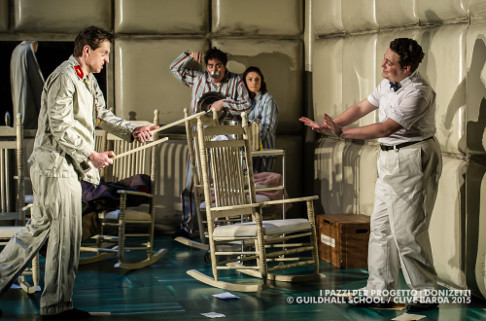 Scene from I Pazzi per Progetto
Scene from I Pazzi per Progetto
Set in an asylum in early nineteenth-century Paris, here the L’Institut de Psychiatrie Experimentale, the plot is almost impossible to follow but revolves around the attempt by the jealous Norina — niece of the Institute’s director, Darlemont — and her equally possessive yet philandering husband, Colonel Blinval, to test each other’s love by pretending to be insane. Other inmates and orderlies include the eccentric Cristina, who has been admitted to the madhouse by her avaricious ward Venanzio, and Don Eustachio, a ‘psychiatrist’ who is actually a trumpeter who has absconded from Blinval’s regiment. Cristina believes her ability to recite bleeding chunks of Molière, Alfieri and Tasso from memory will ‘prove’ her sanity; the deserter Eustachio reels off his ‘accomplishments’ in an aria which foreshadows the fraudulent fancies of Dulcamara’s ‘Udite, udite’. Such are the follies and fancies of the incarcerated. The conflict arises because Blinval has promised to marry Cristina — just as soon, that is, as his decrepit ‘old ’wife drops dead; the arrival of the young, evidently full-of-life Norina, throws this plan off-kilter and the comedy plays out until they all abandon their facades of lunacy and ‘order’ is restored.
At a time when those suffering from mental disorder were beginning to benefit from more sympathetic medical treatments and attitudes, Donizetti stuck with the previous century’s less compassionate approach to the mad, and designer Martin Lloyd-Evans does not let a single opportunity for ridicule and hilarity go unfulfilled — including (fittingly for a score which itself delights in musical parody with Rossini’s Semiramide a particular target) mockery of Donizetti’s own more ‘serious’ mad-scenes. So, we have distressed heroines setting light to chairs, an ‘air’ double-bass obbligato from the increasingly senseless Blinval during Norina’s aria, ‘Tirsi Lontan da Clori’, and a ‘seduction’ aria — why does Cristina launch an amorous attack on the timid Eustachio in order to get him to serve as her messenger?? — which is relished by two voyeur patients, thrilled by the unexpected titillating interruption to the mundane routines of the madhouse.
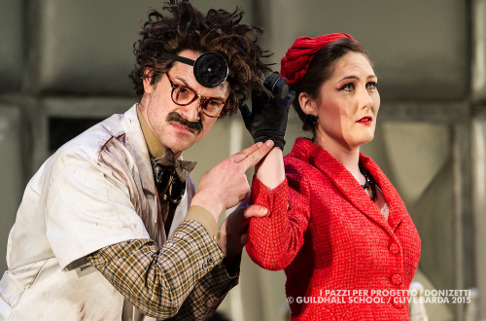 Scene from I Pazzi per Progetto
Scene from I Pazzi per Progetto
And, who knew that rest and recuperation for the mad included not just quiet reading and gentle chair-rocking but also repetiteur-ing? It was an ingenious move to have a pyjama-clad pianist among the patients, providing on-stage accompaniment to the recitatives. And, pianist Ben-San Lau’s keyboard histrionics and dissonant disgruntlement when the singers refused to sing in the appropriate style were an oblique reminder that rather than the opera is unusual for a farce in having recitatives rather than spoken dialogue.
Scored for the unusual combination of soprano, mezzo-soprano and five basses, the dominant contribution is that of Norina, and Laura Ruhl-Vidal proved well-equipped to meet the not inconsiderable technical demands of the role. Norina has two big arias, both requiring considerable stamina, and Ruhl-Vidal’s efforts revealed a sure technique and personable stage presence. Her elaborations remained crisp and clear throughout the aria de sortie and rondo-finale; and, she has a fresh, appealing sound, although she was occasionally under the note.
As Blinval, Szymon Wach began with a full tone, well-shaped phrasing and characterful charm. His first duet with Norina was engaging but towards the close he rather ran out of steam vocally, though the comic japes were deftly executed.Rick Zwart demonstrated similar comic nous as the hapless Eustachio, and he was the most proficient in the cast in dealing with tripping Italian. As the blue-stocking, Cristina, Ailsa Mainwaring revealed a voice of lovely colour and richness, especially in the lower register. David Shipley (Darlemont), David Ireland (the orderly, Frank), and Milan Siljanov (Venanzio) were similarly accomplished and well characterised.
The episodes of the introduzione which follows the brief instrumental prelude are brisk and conductor Dominic Wheeler got things going at a slick pace, building effectively to the first ensemble, a lively quintet. But thereafter the momentum sometimes flagged — there is rather a lot of secco recitative which however enthusiastically delivered did drag things back. While generally secure, the orchestral playing lacked a certain breeziness and spontaneity; and, there were some unfortunate intonation problems in the horns which at one point might have unsettled a singer less self-composed than Ruhl-Vidal. Together, though, the theatrical and music parts added up to an enjoyable and stylish whole.
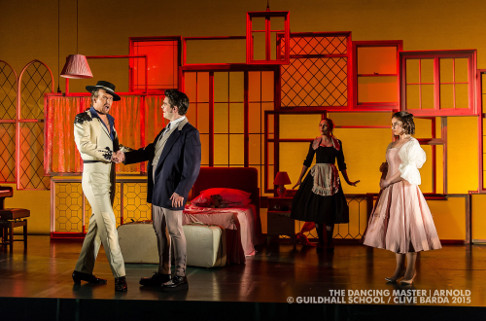 Scene from The Dancing Master
Scene from The Dancing Master
Though composed in 1951, Sir Malcolm Arnold’s The Dancing Master had to wait until the 2012 ‘Malcolm Arnold Festival’ for its first performance — at the Royal and Derngate in Northampton (the composer’s birthplace) by the Ealing Symphony Orchestra under John Gibbons (when it was paired with Strauss’s Die Fledermaus). This GSMD production was billed as the first fully staged performance.
Malcolm Arnold’s success as a composer for the screen was considerable. He composed almost 70 film scores including music for David Lean’s The Sound Barrier, Hobson’s Choice among them, and he won an Oscar for The Bridge on the River Kwai. Yet, despite his popular appeal Arnold, the critics did not — and perhaps still don’t — know quite how to respond to Arnold’s work, which so blatantly rejected the musical experimentations of the 1950s and 60s. And, the feeling has lingered among some that the composer’s music is not worthy of serious listening and acknowledgement. So, this was a welcome opportunity to hear a score which, as one might expect of a gifted film composer, is rich of melody and full of wit and impulsiveness. Wheeler drew very fine performances from stage and pit.
Based on William Wycherley’s 1671 Restoration comedy, The Gentleman Dancing Master, the opera had in fact begun its life as a screenplay. Arnold’s friend, the writer Joe Mendoza, had originally written a film for the actress Margaret Lockwood, but Arnold saw its operatic potential and worked with Mendoza to fabric a libretto from the screenplay. A satire of contemporary manners, the national stereotyping in the text may jar with more modern sensibilities but things dance along frivolously enough.
Miranda, closely watched by her puritanical aunt, Mrs Caution, has been forced into a lamentable betrothal with her cousin — a Francophile dandy who prefers to go by the name ‘Monsieur’. Her preferred suitor is Gerard who, having scaled a ladder to climb into Miranda’s room, is discovered by the young girl’s over-excited father, ‘Don’ Diego, who has just returned from his adored Spain. Gerard professes to be a dancing master whose services are required to bring Miranda’s dancing skills up to Monsieur’s exacting standards. Diego is duped but Mrs Caution demands to see evidence of Gerard’s fancy footwork. There are plans for elopement, machinations by Monsieur and Mrs Caution to prevent the beloveds’ escape, and frequent amorous ‘offensives’ — most startling by Prue, Miranda’s maid, who tries to seduce the reluctant Monsieur! Tempers rise, deceits deepen, and a secret marriage ensues; but, confessing all, Miranda and Gerard beg her father’s forgiveness and seeing the sincerity of their love, he blesses their marriage. After all, as a ‘Spaniard’ he knew the truth all along.
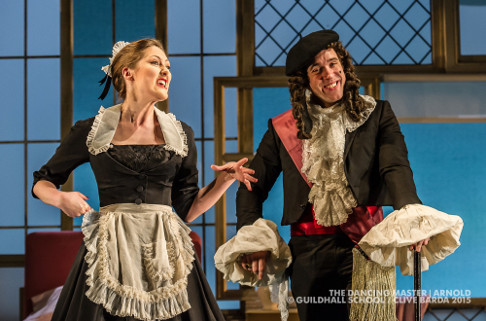 Scene from The Dancing Master
Scene from The Dancing Master
Sets and costumes in both productions were terrific. Just as the padded walls which restrained those incarcerated in the asylum were replaced now by a glittering array of assorted window frames — through which the ‘imprisoned’ Miranda attempts escape and Gerard makes his gallant entrance — so the white lab coats and strait-jackets of the Institute were now replaced by more flamboyant attire. Miranda’s dresses hung from a rail, forming a colour chart of luxury from salmon pink to ebony black. The Hispanophile Diego donned a dashing matador’s regalia while ‘Monsieur’s’ cuffs and curls became ever more extravagant. Richard Howell’s lighting — unusual juxtapositions of complementary tones — considerably enhanced the drama, the movements of colour, sometimes sudden, elsewhere gradual, serving to underscore the alternation of comedy and tender pathos.
Ranging through a medley of styles — Arnold equals Britten as a master of musical pastiche— the woodwind-dominated score was a showcase for some wonderful playing from the young musicians of the Guildhall School of Music, and there were particularly impressive contributions from bassoon, clarinet and horn — perhaps the whooping horn brays were the double entendres that the BBC found too ‘bawdy’ when they rejected the score in 1952? Wheeler crafted a sufficiently transparent texture to allow the voices to come through readily. Though full of good tunes, this is certainly not an ‘easy’ sing, and the precision and focus of their entire cast was admirable, especially in the sextet towards the close.
Alison Rose was excellent as the ill-used heroine Miranda, revealing a flexible, appealing voice which was capable of comic sparkle as well as sorrow and sensitivity. Robin Bailey flounced with Gallic immoderation as the foppish Monsieur, while David Shipley was once again an imposing ‘patriarch’ —and executed a persuasive fandango. Lawrence Thackeray revealed a gleaming, smooth tenor as Gerard, but could do with tempering his full voice with more varied dynamics. Ailsa Mainwaring demonstrated a lovely bloom to her mezzo as the puritanical Mrs Caution and Emma Kerr was convincing as the conniving, cunning Prue.
There were some shared motifs which united the evening’s two-some: on-stage musical charades, characters with a penchant for ‘eloquent’ French interpolations. With all the conflict resolved, and the chaos — at least for the time being — unravelled, the window-walls of Miranda’s bed chamber were raised and the twirling newlyweds were joined by Donizetti’s cast of crazies for a final champagne-fuelled caper. This may have been a light-hearted evening but it was a serious musical undertaking — and delightfully sung and played.
Claire Seymour
Casts and production information:
Donizetti: Il pazzi per progetto
Darlemont, David Shipley; Norina, Laura Ruhl-Vidal; Blinval, Szymon Wach; Cristina, Ailsa Mainwaring; Venanzio, Milan Siljanov; Eustachio, Rick Zwart; Frank, David Ireland.
Arnold: The Dancing Master
Miranda, Alison Rose; Prue, Emma Kerr; Mrs Caution, Ailsa Mainwaring; Monsieur, Robin Bailey; Gerard, Lawrence Thackeray; Diego, David Shipley.
Conductor, Dominic Wheeler; Director, Martin Lloyd-Evans; Designer, Yannis Thavoris; Lighting designer, Richard Howell; Choreographer, Mandy Demetriou. Guildhall School of Music and Drama, Silk Street Theatre, London, Wednesday 4th March 2015.
image=http://www.operatoday.com/10998901_10152757114536365_4214293957248616581_o.jpg image_description=Laura Ruhl-Vidal as Norina in Il pazzi per progetto [Photo by Clive Barda] product=yes product_title=Double bill at Guildhall: Donizetti’s Il pazzi per progetto and Arnold’s The Dancing Master product_by=A review by Claire Seymour product_id=Above: Laura Ruhl-Vidal as Norina in Il pazzi per progettoPhotos by Clive Barda
March 5, 2015
LA Opera: Barber of Seville
Author and playwright Pierre-Augustin Caron de Beaumarchais wrote a trilogy about the Almaviva family: Le Barbier de Séville (The Barber of Seville), Le Mariage de Figaro (The Marriage of Figaro), and La Mère Coupable (The Guilty Mother). Los Angeles Opera presented operas based on the Beaumarchais trilogy during its 2014-2015 season, but not in the order of their composition. 1786 saw the premiere of Le Nozze di Figaro, (The Marriage of Figaro) by Wolfgang Amadeus Mozart. Gioachino Rossini wrote his opera, originally entitled Almaviva, o sia L'inutile precauzione (Almaviva or the Useless Precaution), on the play Le Barbier de Séville in 1816, and it was not until 1991 that John Corigliano’s The Ghosts of Versailles, inspired by La Mère Coupable, saw the light of day.
In January, Los Angeles Opera gave us Figaro 90210, an opera that uses Mozart’s music but has an updated take on the libretto. Angelinos saw the premieres of The Ghosts of Versailles and The Barber of Seville in February and will see performances of The Marriage of Figaro in March and April.
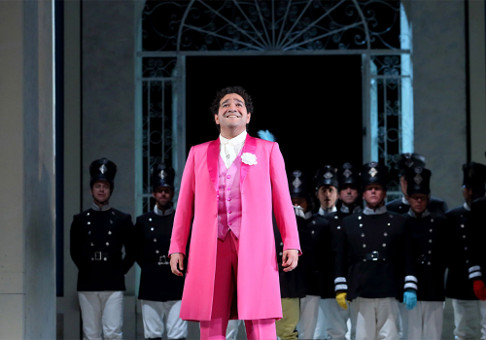 René Barbera as Count Almaviva
René Barbera as Count Almaviva
Saturday, February 28, 2015, was the first night for Los Angeles Opera’s revival of its 2009 presentation of The Barber of Seville, a production by Emilio Sagi, which comes originally from Teatro Real in Madrid in cooperation with Lisbon’s Teatro San Carlos. Sagi and onsite director, Trevor Ross, made comedy the focus of their production and provided myriad sight gags which kept the audience laughing.
Dancers and supers pulled Llorenç Corbella’s lightweight, light colored scenery around the stage as part of Nuria Castejón’s inventive choreography. Numerous dancers who served as townspeople and servants were part of every scene, which gave this Spanish production a particular Flamenco ambiance. As was true of the rest of the visual aspects of the show, Renata Schussheim’s costumes were black and white for all but the colorful finale in which Count Almaviva and Rosina wear bright pink for their departure in a magnificent hot air balloon.
Tenor René Barbera was a lighthearted Count who sang with the utmost in precise coloratura. Elizabeth DeShong is new to Los Angeles, but she has already sung major mezzo-soprano coloratura roles at Covent Garden, the Metropolitan and the Vienna State Operas. The possessor of a distinctive timbre, her waves of vocal color filled the hall with beauty. Baritone Rodion Pogossov, who was the Papageno in Los Angeles Opera’s 2013 presentation of The Magic Flute, was a robust Figaro who convinced the audience that his presence was irreplaceable.
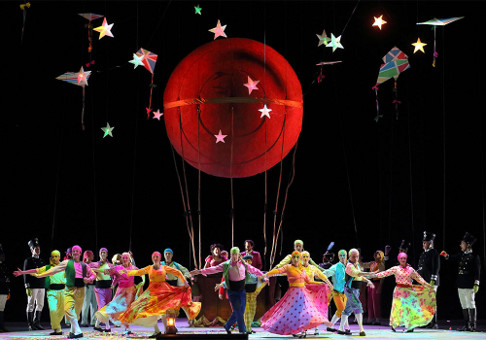 Finale: Elizabeth DeShong as Rosina, and René Barbera as Count Almaviva, are about to take off in the balloon
Finale: Elizabeth DeShong as Rosina, and René Barbera as Count Almaviva, are about to take off in the balloon
Alessandro Corbelli was a blustering Doctor Bartolo while Kristinn Sigmundsson was a conniving Don Basilio whose "La calunnia è un venticello" showed the dark toned resonance of his huge bass voice. Lucy Schaufer was a most amusing Berta, Jonathan Michie an energetic Fiorello, and Frederick Ballentine an enormously nervous sergeant. Chorus Director Grant Gershon’s men sang with alacrity and moved so well that it was hard to tell them from the dancers.
Tamara Sanikidze, who played the accompaniment for the recitatives on the fortepiano, shaped every phrase with taste. Conductor James Conlon mentioned in his pre performance lecture that the production of this Rossini opera he saw as a young boy influenced his decision to spend his life in music. On this evening he imbued the instrumental surfaces of the music with luminous subtleties while holding stage and pit together with bonds of pure musicality. Los Angeles Opera’s Barber of Seville was a treat for both eye and ear.
Maria Nockin
Cast and production information:
Fiorello, Jonathan Michie; Count Almaviva, René Barbera; Figaro, Rodion Pogossov; Rosina, Elizabeth DeShong; Doctor Bartolo, Alessandro Corbelli; Don Basilio, Kristinn Sigmundsson; Berta, Lucy Schaufer; Sergeant, Frederick Ballentine; Conductor, James Conlon; Production, Emilio Sagi; Director Trevor Ross; Scenery Designer, Llorenç Corbello; Costume Designer, Renata Schussheim; Lighting Designer, Eduardo Bravo; Chorus Director, Grant Gershon; Choreographer, Nuria Castejón; Fortepiano, Tamara Sanikidze.
image=http://www.operatoday.com/Barber-public-15146-530.jpg
image_description=Elizabeth DeShong as Rosina [Photo by Craig T Matthew]
product=yes
product_title=LA Opera continues Figaro Trilogy with Barber of Seville
product_by=A review by Maria Nockin
product_id=Above: Elizabeth DeShong as Rosina
Photos by Craig T Matthew
March 3, 2015
Mirabai: New opera, holograms and eternal love
The project has an existing relationship with Musion3D, the world leader in cutting edge holographic technology, which offers unparalleled creative possibilities to engage audiences.
This unusual, unique project has already attracted the interest of acclaimed and multi award winning film director Tony Palmer, who is interested in making a film of the opera, speaking of its universal appeal and potential for enormous international success. “Every element of Mirabai is fascinating — the music, the story, the holograms. This is something which has to be attempted.” He directed a short film of the Krishna dance scene (a version of which was shown at the annual Kinetica Art Festival in London) and appears in a 7 minute video trailer about Mirabai, explaining why he is passionate about the project.
“I have always been a huge admirer of Tony’s work, and he is the perfect director for Mirabai,” comments Seaman. “We are grateful for all his continued belief and support.”
Another fan of the opera is celebrated Russian operatic soprano Marina Poplavskaya, who recorded the Saraswati hologram.
The Mirabai journey began 5 years ago, during which the project has benefited from a range of supporters and advocates. So how was the idea conceived? Seaman reveals, “After a visit to the BAPS Shri Swaminarayan Mandir London (known as the Neasden Temple) I began to explore the life of Mira, whose subversive love for her favourite god Krishna was expressed through her mystic songs and dancing; she sacrificed everything and paid the price. Born into the Rajput aristocracy in the early 16th century, Mira incurred disapproval by choosing Krishna above the deity worshipped by the family into which she had married; and singing and dancing in public in praise of Krishna was behaviour thought unseemly for a princess. Mira confounded societal expectations, rejecting materialism for spiritual awareness and becoming the symbol of a woman who chose her own path and found liberation in non-violent resistance. ”
With poet, dancer and singer/songwriter Mariam Al-Roubi, the composer has been creating a spectacular new opera that is a fusion of intoxicating music, dance, hallucinatory imagery, lighting and pioneering holographic projection to enhance the dreamlike scenes. Says Seaman, “It is a love story, at the same time erotic and divine, and underpinned by international cultural and historical references to emphasise its universal nature, through the Ghosts — spectral figures from other historical times and places. They shine their own light on love, and include characters from Plato’s Symposium, St Teresa of Avila and Argentine tango dancers. The audience does not need to know about Hinduism, or be familiar with these references for the opera to make sense to them, because they are used as a means to communicate the deepest and simplest of human emotions. Like its heroine, Mirabai writes its own rules, communicating in a musical and theatrical language that is rich and vibrant.”
Mirabai is the third of a trilogy. The first two pieces were large-scale choral works: The Consoling Song (words in Sanskrit from the Bhagavad Gita; commissioned by The Brighton Singers and first performed in Brighton UK 2002) and Bhajans (words by Nimisha Patel and Elizabeth Newman; commissioned by The Madrigal Choir of Binghamton and first performed in Binghamton NY USA 2007). In March 2013, The Lake, and Petals, two excerpts from Mirabai, were premiered by the Ealing Symphony Orchestra.
Act 3 of the opera, in which Mira ascends to Vrindivan, where Krishna dwells, is almost completed. Exploring opportunities for innovative and pioneering collaborations with visionary partners is an essential part of the process in order to reach and engage with the widest possible audience. What is needed now is an opera company who recognises the power and potential of Mirabai to attract both existing and new opera and music lovers — now and for future generations.
To see, hear or find out more about Mirabai, contact Jane Seaman, Project Development Manager at workingwords50@gmail.com or Tel: 01622 677214 or 07905 825650
image=http://www.operatoday.com/Meerabai_painting.jpg image_description=Meera bai [Source: Wikipedia] product=yes product_title=Mirabai: New opera, holograms and eternal love product_by= product_id=Above: Meera bai [Source: Wikipedia]March 2, 2015
Bampton Classical Opera Young Singers’ Competition 2015
Bampton Classical Opera has a reputation for its commitment to young talent and a number of singers who have appeared on the Bampton stage have gone on to work with national companies such as The Royal Opera, English National Opera and Opera North.
At the final of the 2013 competition, Ukranian mezzo-soprano Anna Starushkeyvch was awarded first prize and British soprano Rosalind Coad was the runner-up.
Since then Anna Starushkeyvch has performed the role of Erato in Gluck’s Il Parnaso confuso and the title role in Bertoni’s Orfeo (UK première) for Bampton Classical Opera, both during summer 2014. This year she will be singing the role of Ofelia in Salieri’s La grotta di Trofonio, also for the company. Other recent engagements have included the role of Rosimonda in Handel’s Faramondo at the 2014 Göttingen International Handel Festival, which was recorded by Accent Record Producers, and Anna will be repeating her role in the same production at Brisbane Baroque 2015.
Rosalind Coad is now a Scottish Opera Emerging Artist, and recent appearances include the role of Clotilde in Norma for Opera Holland Park 2014. She sang the role of Daughter in the recent Bampton Classical Opera concert performance of Maurice Greene’s Jephtha.
The preliminary rounds of the Bampton Classical Opera Young Singers’ Competition 2015 will take place on 31st October and 1 st November at Westminster School in London. The public final will take place in the Holywell Music Room, Oxford, on 14 November. Judges for the competition are British tenor Bonaventura Bottone, and conductors Andrew Parrott and Peter Robinson.
Competitors can apply by downloading an application form and information document from the Bampton Classical Opera website — www.bamptonopera.org
The deadline for applications is 28th September 2015.
Notes:
Preliminary rounds
15 minute performance maximum. Applicants will prepare three items from which the jury will choose to hear two.
Final
20 minute performance maximum. Varied and balanced programme of contrasting items to include opera and song. At least one work should be in English. One repetition from the preliminary rounds will be allowed.
Eligibility
This competition is open UK residents aged between 21 and 32 on November 14, 2015.
Listings
All tickets to the final are £15 and are available:
By telephone: 01993 851142
By post: 1 Deanery Court, Broad Street, Bampton, Oxfordshire, OX18 2LY
Online: www.bamptonopera.org
Information
Website: www.bamptonopera.org
Telephone: 07500 827264
Email: Harriet@bamptonopera.org
Registered Charity No. 1080541
For further information, please contact:
Margaret Skeet PR
Tel: (020) 8 524 5516
07855 707418
2 March, 2015
image=http://www.operatoday.com/IMGP5956.jpg image_description=Bampton Classical Opera product=yes product_title=Bampton Classical Opera Young Singers’ Competition 2015 product_by= product_id=Marie-Nicole Lemieux, Wigmore Hall
This recital of French mélodies with accompanist Roger Vignoles — which comprised some material from this recording alongside other Gallic chansons — was certainly sensuous and heady, but the soft languor of Fauré, Lekeu and Hahn was balanced by the wit of Charles Koechlin and the poignancy of Duparc.
The gratifying lyricism of Fauré’s Cinq melodies ‘de Venise’ made an engaging opening, and allowed Lemieux to demonstrate her secure technique, the extraordinary range of her tonal palette and the wide compass of her voice, which she can extend down to a full contralto and up to blooming mezzo heights, passing through the registers smoothly and evenly. A native of Québec, Lemieux’s diction was, unsurprisingly, idiomatic. But, Fauré’s settings often prioritise the musical line above the prosody, resulting in occasional misplaced accents and emphasis, and Lemieux was skilful in highlighting textual details and drawing the listener into the song.
Thus, in ‘Mandoline’ the curving melisma with which the composer characterises the serenaders’ ‘tender’ songs was beautifully shaped. And, describing the fair listeners with ‘Leurs longue robes à queues,/ Leur élégance, leur joie/ Et leurs molles ombres bleues’ (their long trailing gowns, their elegance, their joy, and their soft blue shadows), the contralto adopted a breathy conspiratorial tone which contrasted with the bright playfulness of the opening portrait of the lovers exchanging ‘sweet nothings’. This teasing mood had been established by Roger Vignoles’ chirpy, staccato introductory bars and Vignoles’ accompaniments were supportive and attentive throughout, adding splashes of colour and interest — such as the running semi-quavers which ‘shiver’ like the breeze in ‘Mandoline’.
‘En sourdine’ (Muted) was more dreamy, Vignoles’ wave-like arpeggios and Lemieux’s dark tone conjuring the hazy headiness of the calm twilight. Lemieux’s superb control of dynamic extremes was demonstrated at the end of the song, her voice ringing passionately yet forebodingly as evening fell, but fading into sweet softness for the closing consolation, ‘Le rossignol chantera’ (the nightingale will sing). There were flashes of vocal power in ‘Green’, too, judiciously enriching the musical line, and particularly impressive was the way Vignoles used the semi-quaver movement in the inner voices both to colour the piano’s repeating quavers and engage with the voice.
A similar sense of unity was achieved at the opening of ‘C’est l’extase’ (It is rapture), the piano’s rising motif sparkling deliciously to conclude the singer’s slow opening line, ‘C’est l’extase langoureuse’ (It is languorous rapture). In this song, Lemieux moved fluently from high to low and back again, the voice even and lovely across the registers. The highlight of the Fauré songs was ‘A Clymène’: the lucid gentility of the opening captured the mesmerising mystery of Verlaine’s poetry, the moments of power evoked the intoxicating richness of the beloved’s ‘rare scent’, while the floating beauty of the final line, ‘Ainsi soit-il!’, supported by Vignoles quiet, upwards-sweeping triplets, confirmed the lover’s submission to his desire.
Guillaume Lekeu’s settings of his own texts, ‘Trois Poèmes’, reveal the influence of the composer’s worshipful admiration for his teacher, César Franck. The sobriety of ‘Sur une tombe’ (On a tomb) was established by the quiet melancholy of the piano’s opening phrase and the gravity was sustained by the composure and precision — rhythmic, dynamic — of the expressive vocal line. The clouds and shadows were lifted by the clear textures of Vignoles’ insouciant introduction to ‘Ronde’ (The dance), and in this song Lemieux demonstrated the easy flexibility of her voice, most especially in the declamatory second stanza with its temporal ebbs, flows and elongations which mimic ‘Les murmures d’amour de ce beau soir d’été’ (love murmuring on this beautiful summer evening). At times she employed a full vibrato to intensify a note or phrase, most effectively in the final stanza, the voice shimmering glossily through the translucent moonlight painted by Vignoles high, crystalline line. In ‘Nocturne’ Lemieux’s vocal line unfolded sweetly and mellifluously above the piano’s busy accompaniment.
The suspended, rocking chords which open ‘Offrande’ (Offering) by Reynaldo Hahn transported us to a world far removed from Fauré’s ‘Green’, which sets the same Verlaine text — and reminded us of the predilection for the exotic and oriental in late-nineteenth-century France. Lemieux’s melody was wonderfully focused and well-shaped, particularly in the final stanza, ‘Sur votre jeune sein laissez rouler ma tête’ (On your young breast let me cradle my head); and the delicacy of Vignoles’ placing of the oscillating chords, and of the low bass G which finally intimates resolution, was incredibly moving. ‘L’heure exquise’ (Exquisite hour) sparkled tremulously, with Lemieux once again injecting a dash of the moon’s precious gleam. ‘Fêtes galantes’ offered another opportunity to compare Hahn’s approach to text setting with that of Fauré in ‘Mandoline’. Here, the piano’s rippling chords and high right-hand circling motif created a sense of the serenaders’ festive excitement, and this was enhanced by Lemieux’s elegant execution of the extravagant, ornamented leaps which depict the listeners’ luxurious attire.
The tranquillity of the opening of ‘D’une prison’ (From a prison) — written by Verlaine when he was imprisoned in Brussels after his attack on his lover Arthur Rimbaud in 1873 — created deep pathos, Vignoles’ dark bass line and superb pedalling creating momentum and direction. The poet-speaker’s rhetorical cry ,‘Mon Dieu, mon Dieu, la vie est là’ (My God, my God, life is there), was penetrating but still restrained and controlled, falling to a low monotonal murmur reflecting the peace of the world outside the prison walls. The piano’s eloquent rising flourish initiated the self-reflections and recriminations of the final verse. This was indeed a probing and insightful interpretation by the performers.
If we returned after the interval expecting more of the same — one danger of such a programme might be a lack of variety — five songs by Charles Koechlin quickly rectified any potential misconception. In ‘Menuet’ Vignoles’ understated pastiche dance seemed indifferent to the singer’s lamentations, until the final verse when Lemieux joined with the piano to dramatically exclaim her distress, ‘Ah! Comme vous broyez les coeurs’ (Ah! How you break hearts). The piano’s quiet ripples at the start of ‘Si tu le veux’ (If you so desire) created a propelling animation. And, Lemieux balanced tenderness and passion, conveying both the purity and sensuality of the poet-speaker’s desire, most seductively in the port de voix — a sweeping octave fall — which joins the image of the beloved, dishevelled by the wind, to the final line: ‘Si tu le veux, ô mon amour.’
Three songs from Sept Rondels Op.8 completed the Koechlin sequence. ‘La pêche’ (Fishing) moved persuasively between lightly articulated episodes, conveying the fisherman’s joy in his work, and surprisingly statuesque passages, with deliberately placed accents, which conjured both broad vistas and the abundant weight of the fisherman’s catch. The asymmetries of ‘La lune’ perfectly embodied the capriciousness of the moon with her frivolous ways. The piano’s trembling glissandi blew like a cold, dry gust of wintery air through ‘L’Hiver’, the monotone recitation and bare fifths in the left hand conveying the unalleviated uniformity of the snow-covered Bois de Boulogne.
It was a delight to hear these seldom performed songs by Hahn, Lekeu and Koechlin, but there was familiar fare on offer too, and Debussy’s Fêtes galantes Book II followed. Lemieux made much of the text in ‘Les ingénus’, her low voice silky and enticing. The gradual deceleration was well controlled and the fading of the evening light in the third stanza was enigmatic and magical; Vignoles’ delicate grace notes and ebbing augmented triads lent an air of strangeness to the final image of the lovers whose startled souls tremble eternally at the remembrance of the pretty girls’ dreamy ‘fair-seeming words’. In ‘La faun’ Lemieux unleashed all the smoky mystery of her full contralto colour while Vignoles’ distant low fifths, oscillating rhythmically, conjured the mercurial faun’s laughter and twirling dance. ‘Colloque sentimental’ (Lovers’ dialogue) was profoundly moving and the performers assailed the interpretive challenges superbly. Lemieux’s melody was emotive and expressive above the sparse accompaniment, yet details were never exaggerated and the tone was even and controlled. Her breath-control and phrasing were excellent, the syllabic setting never interfering with the flow of the vocal line. Even at the bottom of her range, the singer’s voice spoke clearly and truly, and the three ‘voices’ in the text were clearly distinguished.
Four songs by Henri Duparc concluded the recital. In ‘Invitation au voyage’ there was a captivating, sudden change at the moment when the lover imagines the destined place, ‘Là, tout n’est qu’ordre et beauté,/ Luxe, calme et volupté’ (There — nothing but order and beauty dwell, abundance, calm and delight), as the piano’s rapid semiquavers gave way to quiet, expansive chords, shimmering like a mirage, the simplicity of the vocal line evoking wonder and hope. The syncopated fluidity of the piano’s right hand line in ‘Sérénade florentine’ suggested the inscrutability of the night sky, giving way to increasing definition in the closing passages as the star assumes metaphoric presence, alighting on the sleeping beloved like a kiss, a white treasure which embodies their love. ‘Phidylé’ pulsed with controlled passion, the slow steady crotchets of the accompaniment evolving into triplets, then semiquavers, ever more invigorated as the performers created a compelling urgency. Most spell-binding of all was ‘La vie antérieure’ (A previous life). Lemieux’s tone was truly stunning in the solemn opening stanza, as Baudelaire’s poet-speaker describes his former life beneath vast colonnades that look in the evening light, like ‘grottes basaltiques’ (basalt caves). The poetic images were wonderfully captured in sound: hypnotic swaying cross-rhythms, driving forward, revealed ‘Les houles, en roulant les images de cieux’ (The sea-swells, mingling with the mirrored skies); grandiose and impassioned pounding quavers depicted ‘des esclave nus, tout imprégnés d’odeurs’ (naked slaves all drenched in perfume).
Reading these Parnassian poets, one might be tempted to concur with Fauré’s view that ‘their form, so elegant, pretty, and sonorous, resides entirely in the word — and because the word does not hide a single true thought … [the] verse is too full, too rich, too complete for music to be effectively adapted to it’. But, Lemieux and Vignoles made these settings endlessly fascinating and absorbing.
Claire Seymour
Programme:
Gabriel Fauré — Cinq mélodies ‘de Venise’ Op. 58; Guillaume Lekeu —Trois Poèmes; Reynaldo Hahn —‘Offrande’, ‘D'une prison’, ‘L'Heure Exquise’, ‘Fêtes galantes’; Charles Koechlin — ‘Menuet’ and ‘Si tu le veux’ (from 5 mélodies Op.5), ‘La pêche’, ‘La lune’, ‘L’hiver’ (from 7 rondels Op. 8); Claude Debussy — Fêtes galantes Book II; Henri Duparc — ‘L'invitation au voyage’, ‘La vie antérieure ‘, ‘Sérénade florentine’, Phidylé
Marie-Nicole Lemieux contralto, Roger Vignoles piano. Wigmore Hall, London, Friday, 27 February 2015.
image=http://www.operatoday.com/Marie-Nicole_Lemieux.png image_description=Marie-Nicole Lemieux [Photo by Manuel Cohen] product=yes product_title=Marie-Nicole Lemieux, Wigmore Hall product_by=A review by Claire Seymour product_id=Above: Marie-Nicole Lemieux [Photo by Manuel Cohen]